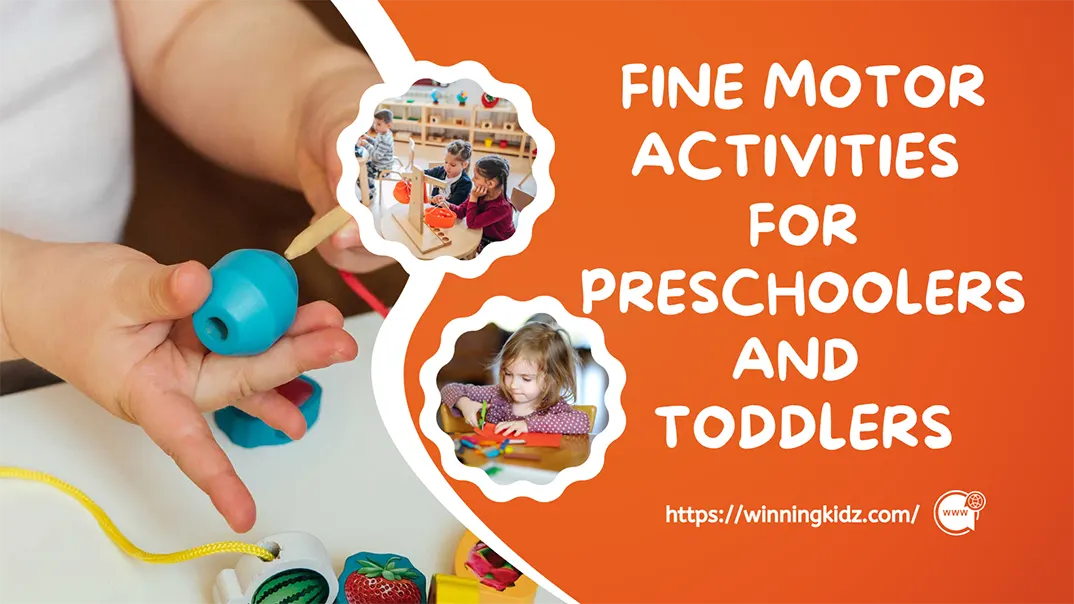Have you ever noticed your preschooler struggling to hold a pencil, use scissors, or button up their shirt? These everyday tasks might seem simple to adults, but they require a set of skills known as fine motor abilities. Without enough practice, many children fall behind in developing these essential skills. So, how can we support young learners in a fun, stress-free way? What tools or games can help them grow stronger, steadier hands? That’s where fine motor activities for preschoolers come in—offering a playful path to vital development.
Fine motor activities for preschoolers are hands-on tasks that strengthen the small muscles of the hands, fingers, and wrists while improving coordination and control. These activities are more than just play—they’re foundational exercises for writing, feeding, dressing, and even tying shoes. From simple threading games to creative art projects, introducing children to a variety of fine motor tasks at an early age helps them build confidence and independence. Whether at home or in the classroom, these skill-building games transform learning into something fun and approachable.
In the sections that follow, you’ll discover 30+ fun and easy fine motor activities for preschoolers and toddlers. Ready to unlock your child’s potential with creative, skill-boosting fun? Let’s dive in and explore the world of fine motor magic!
What Are Fine Motor Skills?
Fine motor skills refer to the ability to make precise movements using the small muscles in the hands, fingers, and wrists. These skills are essential for tasks like grasping a crayon, buttoning a coat, picking up small objects, or using utensils during mealtime. In early childhood, especially during the preschool years, developing these abilities is a critical part of overall growth.
Mastering fine motor skills doesn’t happen overnight. It’s a gradual process supported by repeated practice and engaging, age-appropriate challenges. By incorporating targeted fine motor activities for preschoolers, caregivers and educators can guide children through fun ways to practice these movements, setting them up for long-term success.
Fine Motor Skills Examples
Fine motor skills come into play in countless daily tasks that adults often take for granted. For preschoolers, these skills are still developing and require frequent, playful practice. Let’s explore some common and important examples of fine motor skills that children begin to develop in early childhood.
- Grasping and Holding Objects: Picking up small toys, gripping a pencil or crayon, and holding onto a toothbrush are all early examples of fine motor development. These actions require finger strength and coordination, which are vital for writing and drawing.
- Buttoning and Zipping: Managing clothing closures like buttons, snaps, or zippers helps children build dexterity and hand-eye coordination. These tasks also foster independence in getting dressed.
- Cutting with Scissors: Using scissors is a classic fine motor activity for preschoolers, challenging both coordination and control. Cutting along lines or around shapes builds focus and strengthens hand muscles.
- Using Utensils: Holding a spoon or fork, scooping food, and bringing it to the mouth without spilling are everyday activities that rely on refined fine motor control.
- Stringing Beads or Lacing Cards: These activities require children to use their fingers to thread objects through small holes, enhancing precision and bilateral coordination.
- Stacking and Building with Blocks: Though it may seem like gross motor play, stacking small blocks or constructing with LEGO bricks calls on fine motor skills to control placement and balance.
- Puzzles and Pegboards: Manipulating small puzzle pieces or inserting pegs into holes helps develop spatial awareness and the ability to manipulate objects with precision.
Why are Fine Motor Skills Important?
Fine keterampilan motorik are foundational to a child’s ability to perform essential everyday tasks with confidence and independence. These small muscle movements affect nearly every aspect of a preschooler’s life—from learning to write their name to feeding themselves or getting dressed without help. Developing these skills early sets the stage for future academic success and self-sufficiency.
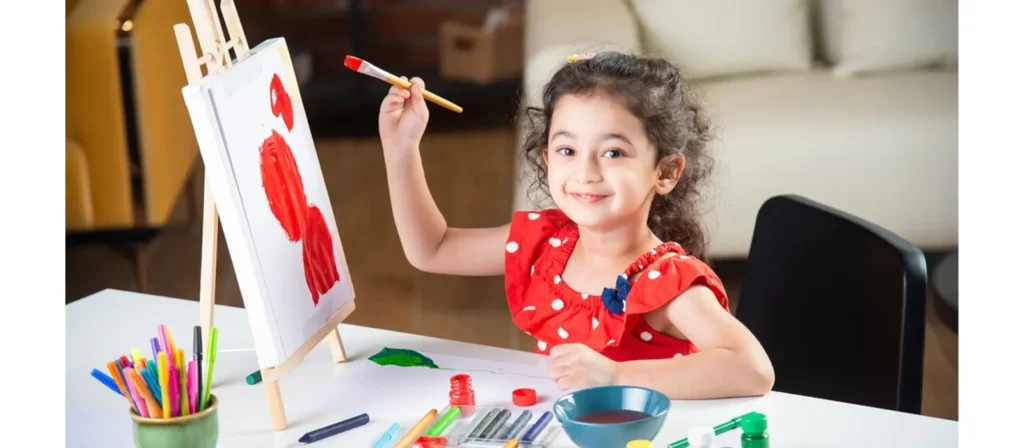
Support Independence in Daily Life
Fine motor skills empower preschoolers to perform everyday self-care tasks like dressing, feeding, and brushing their teeth. These actions might seem minor, but for a young child, managing buttons, using utensils, or squeezing toothpaste builds both ability and confidence. When children can handle these tasks on their own, they feel more in control of their world, fostering independence and a healthy sense of self.
Lay the Foundation for Writing and Drawing
Before a child can write letters or draw shapes, they must first develop the muscle control needed to hold and move a pencil with accuracy. Fine motor strength and finger dexterity are crucial here. Without it, writing becomes a struggle rather than a skill to master. Early practice with crayons, markers, and other writing tools helps children transition smoothly into academic expectations.
Enhance Hand-Eye Coordination
Many fine motor tasks require children to coordinate what they see with how their hands move. Activities like stacking blocks, threading beads, or completing puzzles all challenge this connection. Strong hand-eye coordination not only supports fine motor growth but also contributes to spatial awareness and visual perception—skills that are essential for reading and physical play.
Improve Focus and Patience
Fine motor tasks often involve detailed, repetitive actions that require a child’s full attention, whether it’s placing pegs into a board or carefully cutting along a line. As children engage in these focused activities, they practice patience, concentration, and perseverance. These are soft skills that carry over into all areas of learning and social development.
Prepare Children for School Readiness
Many classroom activities—like using scissors, turning book pages, or gluing pieces of paper—rely on well-developed fine motor skills. If a child struggles with these basics, they may fall behind or feel frustrated. Strengthening these abilities before kindergarten ensures they can focus on learning concepts rather than being held back by physical limitations.
30 Fine Motor Activities for Preschoolers and Toddlers
Fine motor development is a critical part of early childhood learning, and the best way to build these skills is through play. This section introduces 30 engaging, age-appropriate fine motor activities for preschoolers and toddlers that support hand strength, coordination, and control. Designed to be simple, low-prep, and fun, these activities make it easy for educators and parents to incorporate meaningful motor skill practice into everyday routines.
1. Bead Stringing
In this calming, hands-on fine motor activity, children use both hands to thread chunky beads onto a shoelace or piece of stiff yarn. They choose beads based on color, shape, or sequence, which adds a layer of decision-making. The threading motion encourages patience and focus, while the process of selecting and sliding beads builds hand coordination. It’s a perfect seated activity that feels creative and satisfying from start to finish.
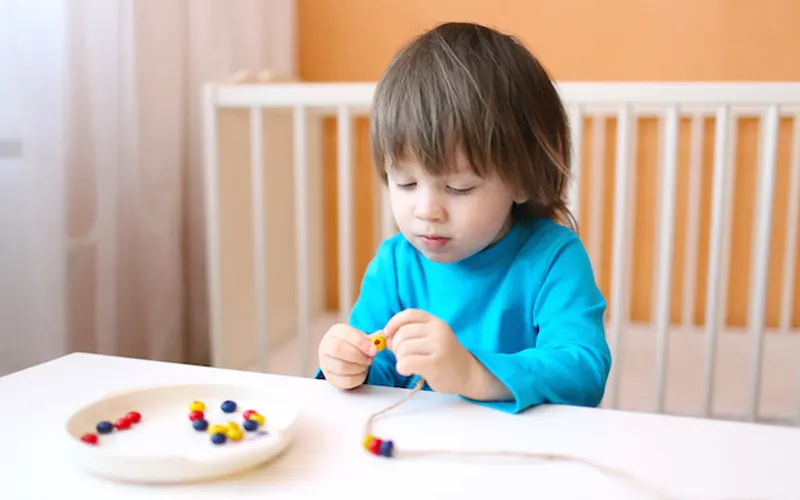
Bahan:
- Shallow tray or bowl
- Plastic beads or wooden threading beads
- Shoelaces or yarn
Preparation:
Mix various beads in a tray to encourage choice and exploration. Ensure lace tips are firm for easy threading. Avoid pre-sorting to make the task more interactive.
Tangga:
- Show how to hold the string and push it through a bead’s hole.
- Let the child choose and thread beads at their own pace.
- Offer light guidance but allow autonomy in the process.
- Help tie the ends into a wearable or decorative strand.
- Repeat with new color sets or bead types as desired.
Creative:
Introduce pattern-making, letter beads to form names, or ask children to sort before threading. Older kids can create themed “story necklaces” using bead colors or symbols.
Nilai Pendidikan:
This fine motor activity enhances bilateral coordination, hand strength, and pincer grip—all essential for writing and self-care tasks. Pattern-making develops early math and sequencing skills. Visual scanning and decision-making are practiced naturally, improving focus and cognitive flexibility.
2. Pom-Pom Transfer with Tongs
Children use tongs or tweezers to pick up fluffy pom-poms and transfer them into cups or muffin tin compartments. The gripping and releasing motion requires control and precision, which boosts finger strength. It also encourages patience, concentration, and deliberate movement. Kids enjoy the tactile aspect and often treat it like a game, especially when challenged to sort by color or beat their own time.
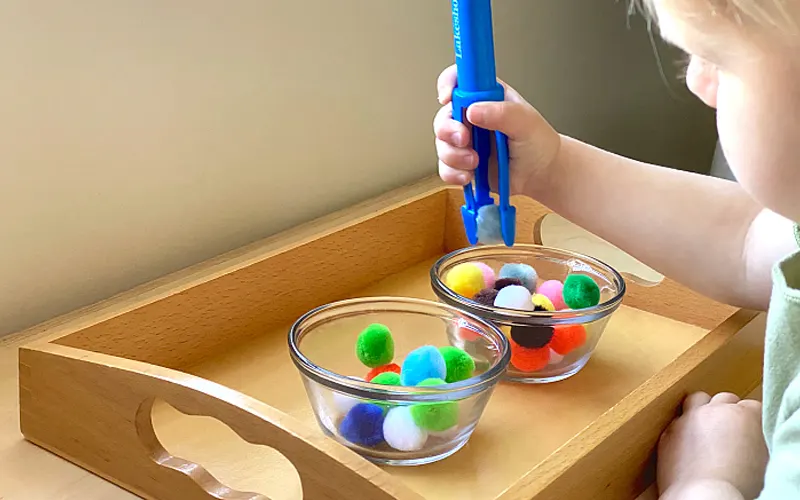
Bahan:
- Muffin tin, egg carton, or small bowls
- Pom-poms (variety of colors and sizes)
- Child-safe tongs or tweezers
Preparation:
Scatter pom-poms in a shallow tray or bowl. Place empty sorting containers nearby. Choose tongs suitable for small hands that offer some resistance but aren’t too stiff.
Tangga:
- Demonstrate gripping and transferring a pom-pom with tongs.
- Invite the child to do the same, moving pom-poms into containers.
- Gradually introduce sorting by color or size if appropriate.
- Encourage repetition and variation to build fluency.
- Celebrate effort over speed or accuracy.
Creative:
Add a timed race element or a rule-based game (e.g., “no two same colors in a row”). Older kids can use chopsticks or transfer pom-poms across obstacle paths.
Nilai Pendidikan:
This activity boosts the pincer grasp, hand strength, and fine motor endurance. Sorting enhances cognitive organization and early math readiness. The tool-based action encourages refined hand control, supporting pre-writing and self-care skills.
3. Sticker Line Tracing
This quiet but engaging fine motor activity involves placing small stickers along drawn lines, helping children develop hand control and concentration. Kids love the freedom to choose sticker colors and the satisfaction of filling in lines completely. The linear path gives structure, while sticker placement allows creativity. It’s a great independent activity that blends art and precision with minimal setup.
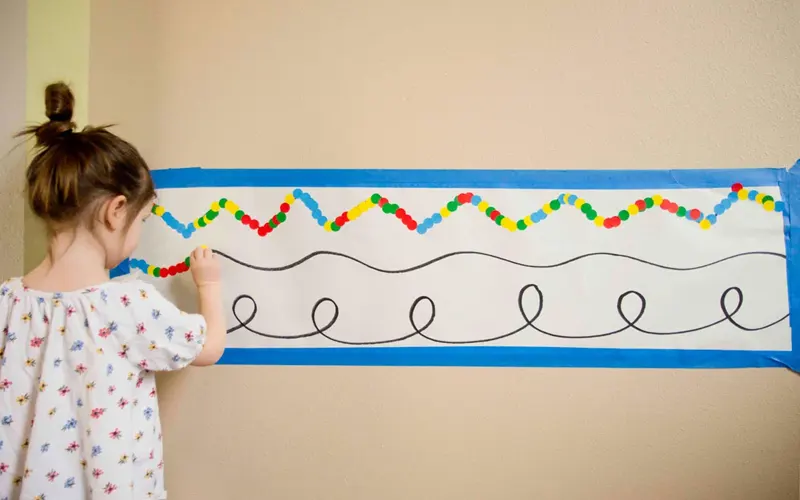
Bahan:
- Sticker sheets (dots, stars, or themed stickers)
- Large sheet of paper
- Marker to draw straight, wavy, or zigzag lines
Preparation:
Draw a few lines of varying difficulty across the paper. Peel one sticker to demonstrate the concept. Use simple shapes for younger children and more complex curves for older ones.
Tangga:
- Instruct the child to place stickers along the drawn line.
- Start with easier straight lines and progress to wavy ones.
- Provide support only if they struggle with sticker handling.
- Continue until the entire line is filled.
- Allow them to admire or decorate further if inspired.
Creative:
Turn the lines into roads, rainbows, or vines, and use stickers that match the theme. Invite older children to draw their own paths and create freely.
Nilai Pendidikan:
Sticker tracing enhances finger strength, spatial awareness, and directionality—skills essential for writing. This fine motor activity builds patience and persistence as children work through a linear task. Visual tracking and motor planning are also exercised, supporting both early literacy and numeracy.
4. Button Snake Craft
In this hands-on fine motor activity, children thread felt squares onto a ribbon with a button sewn at one end, mimicking the buttoning motion used in dressing. Each felt square must be aligned and maneuvered onto the ribbon through a small slit, encouraging careful finger work. It’s an excellent quiet-time task that builds coordination through a focused, repetitive motion. Kids enjoy watching their “snake” grow longer with each successful thread.
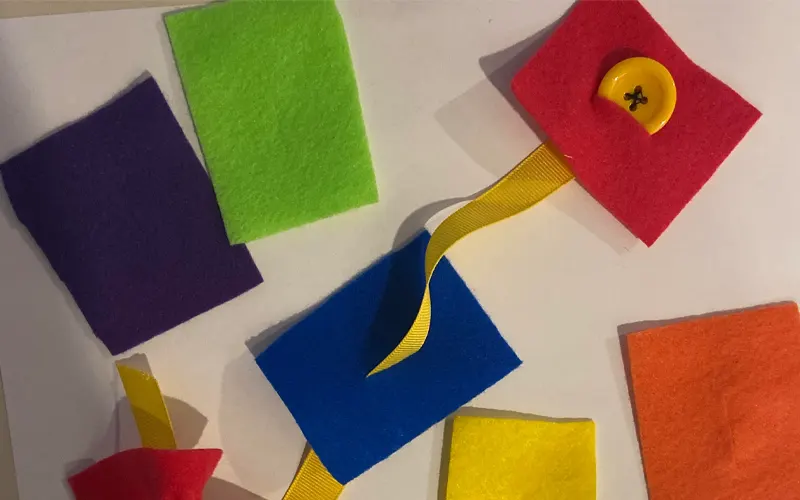
Bahan:
- Pita
- Large button (sewn onto one end of the ribbon)
- Felt squares (each with a vertical slit in the center)
- Needle and thread (adult use only)
Preparation:
Sew a large button securely onto one end of the ribbon. Cut felt squares (about 2.5 inches each) and snip a vertical slit into the center just wide enough to push the button through.
Tangga:
- Show how to push the button through the slit in a felt square.
- Let the child slide the square down the ribbon.
- Repeat until all pieces are threaded.
- Invite them to remove and repeat the process independently.
- Store for reuse or use the finished “snake” as a toy.
Creative:
Older children can create color or shape sequences, design themed “snakes” (e.g., using animal print felt), or glue decorations onto the felt pieces before threading to personalize their creation.
Nilai Pendidikan:
This fine motor activity strengthens the coordination needed for real-world dressing tasks like buttoning and fastening. It improves bilateral coordination, visual-motor precision, and the ability to align and manipulate flexible materials. The focus and sequencing involved enhance executive function and patience.
5. Pasta Threading
Children thread dried pasta with holes onto pipe cleaners or yarn, creating simple jewelry or abstract shapes. The rigidity of the pasta makes it easy to handle, while the repetitive motion of sliding each piece into place provides excellent fine motor practice. This open-ended fine motor activity allows for both structured and creative exploration, making it a flexible choice for any developmental stage.

Bahan:
- Dried pasta with holes (e.g., penne, rigatoni)
- Pipe cleaners or string
- Small bowls for pasta portions
- Optional: food coloring or markers to color pasta
Preparation:
Separate pasta into small containers. Cut pipe cleaners or string to manageable lengths. Pre-color the pasta using food coloring and let it dry, if desired.
Tangga:
- Show how to hold the pipe cleaner and slide on a piece of pasta.
- Invite the child to thread as many pasta pieces as they like.
- Help twist the ends to form bracelets or rings.
- Allow for repetition with different pasta shapes or patterns.
- Store finished creations or reuse pasta for new projects.
Creative:
Older children can create intentional shapes or structures (like letters, spirals, or 3D shapes), experiment with alternating pasta types, or build themed accessories (e.g., “jungle bracelets” using green pasta).
Nilai Pendidikan:
Pasta threading promotes hand stability, dexterity, and bilateral coordination. This fine motor activity improves focus through repetitive action and introduces basic design and patterning skills. It supports creative expression while reinforcing spatial awareness and planning.
6. Cotton Ball Push Race
In this active and playful fine motor game, children push cotton balls across a smooth surface using small tools like basters, toy hammers, or even just their fingers. The goal can be to race a friend to the finish line or simply complete a path. It combines gentle upper-body movement with careful hand control, creating a fun crossover between gross and fine motor development.

Bahan:
- Bola kapas
- Squeeze toys, silicone basters, or soft brushes
- Painter’s tape to mark start and finish lines (optional)
- Smooth floor surface (wood or tile works best)
Preparation:
Place cotton balls on one side of the room or hallway. Use tape to mark a starting line and a finish line. Give each child a tool for pushing (or let them choose). Clear the floor space of obstructions.
Tangga:
- Demonstrate how to push a cotton ball gently across the floor using the tool.
- Have the children kneel or crouch and start behind the starting line.
- On your signal, let them race to push their cotton balls to the finish.
- Repeat as desired, switching tools or lengths.
- Optional: introduce paths, curves, or small obstacles for more challenge.
Creative:
Older kids can push the cotton balls through mazes made with blocks or tape, use a straw to blow instead of push, or create team relays. You can also assign different point values based on which “goal” the cotton ball reaches.
Nilai Pendidikan:
This fine motor activity enhances shoulder and upper-arm stability while reinforcing controlled fine motor movement through pushing. It sharpens hand-eye coordination, timing, and pressure awareness. The playful race format encourages physical engagement while still building precision, pacing, and motor planning—essential pre-writing and tool-use foundations.
7. Cutting Lines Challenge
In this fine motor activity, children practice cutting along various lines printed on paper from straight to zigzag and curved paths. It’s a seated tabletop task that allows for quiet repetition while strengthening hand control. Each line becomes a mini goal, and the visual structure gives children clear feedback on their progress. Most children take pride in seeing how accurately they can follow the path with their scissors.
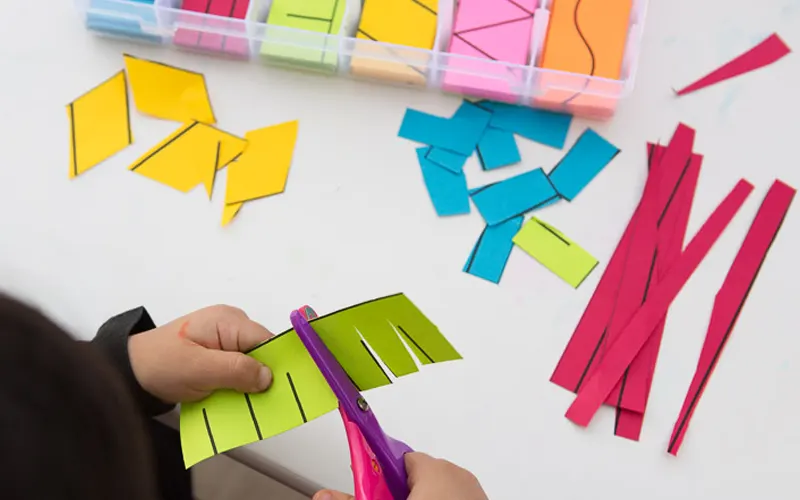
Bahan:
- Gunting yang aman untuk anak-anak
- Printed cutting worksheets with different line types (straight, curved, zigzag)
- Tray or folder for collecting completed strips
Preparation:
Print or draw multiple types of cutting lines on strips of paper. Arrange scissors and worksheets on a flat surface, and demonstrate safe scissor handling beforehand.
Tangga:
- Show the child how to position their fingers in the scissor loops.
- Guide them to cut along a straight line, then move to more complex paths.
- Encourage independence while offering help with hand positioning if needed.
- Save cut pieces for optional gluing activities.
- Rotate new line styles weekly to increase variety and difficulty.
Creative:
Older children can design their own cutting paths or turn completed pieces into paper animals, patterns, or layered art. Introduce wavy lines with loops or spirals for extra challenge.
Nilai Pendidikan:
This fine motor activity develops essential fine motor strength and scissor control. It improves bilateral coordination as one hand cuts and the other stabilizes the paper. The visual tracking required builds reading readiness, while the varied line patterns reinforce attention, focus, and spatial reasoning.
8. Push-Pin Picture Tracing
Children use child-safe push pins to poke holes along the outlines of simple pictures or shapes on paper, placed over soft foam. This fine motor activity involves focused hand pressure and careful control, mimicking the precision needed for writing. Children often find the quiet, repetitive poking soothing and love holding their finished “perforated” art up to the light.

Bahan:
- Child-safe push pins or large-headed tacks
- Printed shapes or simple drawings on paper
- Thick foam board or cork mat as a base
- Tape to secure the paper in place
Preparation:
Tape the outline drawing onto the foam surface. Demonstrate how to hold the pin and apply gentle, steady pressure while keeping the non-dominant hand safely out of the way.
Tangga:
- Help the child sit comfortably with the paper secured on foam.
- Show how to poke holes along the outline of the picture.
- Let them continue independently, checking for even spacing.
- When finished, remove the paper and hold it up to see the design.
- Store completed “dot art” or back it with colored paper for display.
Creative:
Older children can create their own outline drawings or use this method to write their names. Try placing a flashlight behind finished pieces to turn them into “light art” displays.
Nilai Pendidikan:
Push-pin tracing enhances finger strength, pressure control, and precision—all of which support handwriting development. The slow, deliberate movement helps improve patience and concentration. Visual-motor integration is strengthened as children align their movement with the outline.
9. Sensory Bag Letter Tracing
This mess-free sensory experience invites children to trace letters, shapes, or numbers on top of a sealed bag filled with gel or liquid. They use a finger to “write” on the bag’s surface, revealing the shape underneath. It’s a gentle, soothing fine motor activity that provides tactile feedback without any cleanup—perfect for early writing practice or calming transitions.
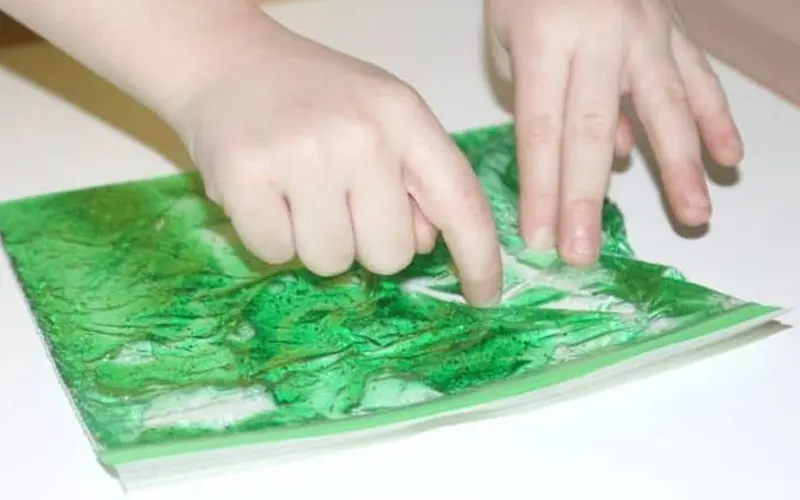
Bahan:
- Resealable plastic bags
- Hair gel or colored shampoo
- Duct tape (to seal edges)
- Optional: glitter, beads, or food coloring for visual appeal
- Printed letters or shapes to place underneath
Preparation:
Fill a plastic bag with 2–4 tablespoons of gel or shampoo. Seal the bag tightly and reinforce all edges with duct tape. Tape the bag onto a table with a printed letter or shape sheet underneath.
Tangga:
- Instruct the child to press gently on the bag to trace the shape underneath.
- Start with large letters or lines and progress to smaller shapes.
- Allow them to explore freely, drawing and erasing with a swipe.
- Change the underlying guide sheet for variety.
- Replace bags periodically to maintain cleanliness and texture.
Creative:
Advanced learners can use the bags to trace entire words, create their own letters without guides, or form pictures. You can also introduce “mystery shapes” for guessing games.
Nilai Pendidikan:
This fine motor activity provides rich sensory input, helping regulate energy and increase focus. It builds finger isolation, pressure awareness, and shape formation—all essential for writing. The multisensory format supports visual, tactile, and kinesthetic learning, especially beneficial for children who struggle with pencil-and-paper tasks.
10. Tear and Paste Paper Collage
Children rip pieces of colored paper and glue them onto templates to create collages. The tearing action builds finger strength, while gluing allows for creative assembly. It’s a tactile, open-ended art experience that supports controlled movement in a relaxed format. Children often enjoy the freedom to choose shapes, colors, and layout as they build their artwork piece by piece
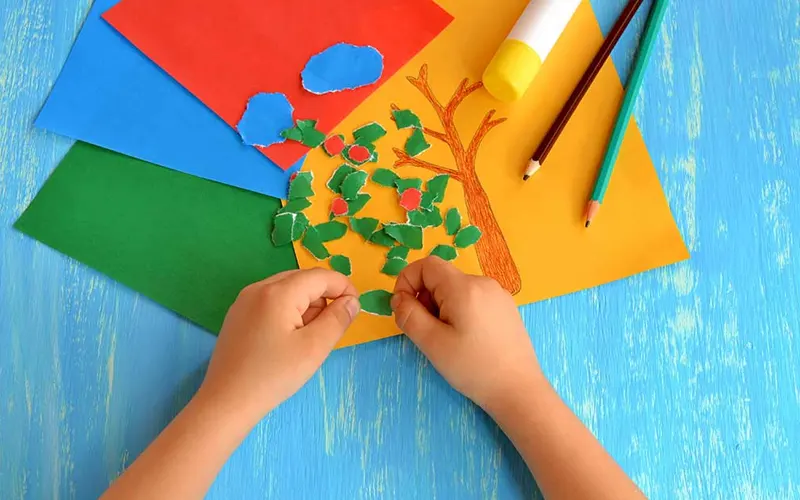
Bahan:
- Colored paper or old magazines
- Child-safe glue sticks
- Blank paper or templates (like animals, letters, or shapes)
- Optional: tray or container to hold torn pieces
Preparation:
Pre-cut larger sheets of paper and let children tear them into smaller pieces. Provide blank or outlined templates to guide collage placement.
Tangga:
- Show the child how to tear paper into small chunks.
- Provide glue and a surface for arranging the pieces.
- Let them paste freely or follow a guided shape.
- Encourage layering and experimentation.
- Allow drying time and display finished creations.
Creative:
Older kids can use patterned paper, add textures (like foil or fabric), or design entire landscapes. Challenge them to “paint with paper” by selecting colors that match a photo or image.
Nilai Pendidikan:
This fine motor activity builds grip strength, hand control, and bilateral coordination as one hand tears and the other holds. Gluing requires fine precision and spatial planning. Creative choices boost expressive language and visual planning. It’s an excellent bridge between motor practice and artistic development.
11. Velcro Craft Stick Shape Builder
In this hands-on construction fine motor activity, children use colorful jumbo craft sticks with Velcro dots attached at both ends to build 2D geometric shapes like triangles, squares, and rectangles. The soft click-and-stick action of Velcro makes connecting the pieces easy and fun, while also providing sensory feedback. As kids explore how to link and angle the sticks to form different structures, they engage both creative thinking and precise hand control.
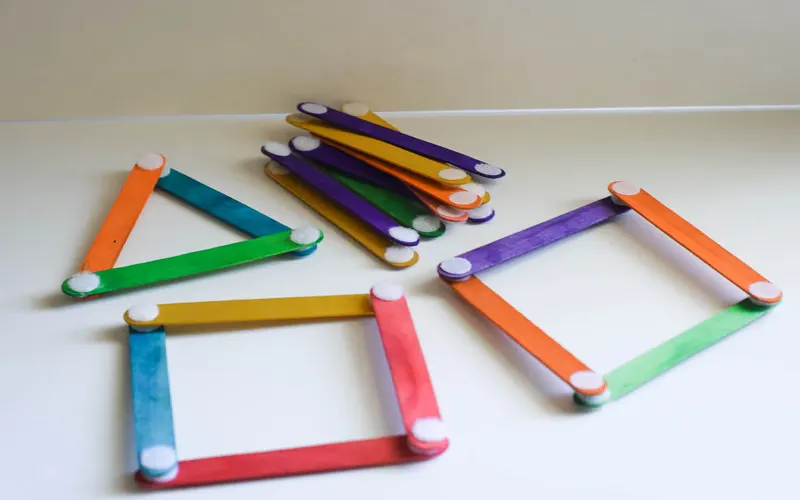
Bahan:
- Jumbo craft sticks (colored or painted)
- Self-adhesive Velcro dots (hook and loop sides)
- Flat surface for building
- Optional: printed shape cards for matching
Preparation:
Stick one hook dot and one loop dot on opposite sides of each craft stick’s ends so they can attach to others from any angle. Make at least 15–20 sticks for flexibility. Prepare a few simple shape templates (e.g., triangle, square) as visual guides if needed.
Tangga:
- Introduce the sticks and demonstrate how to connect two ends using the Velcro.
- Invite the child to build basic shapes like triangles and squares by connecting three or four sticks.
- Encourage them to test and adjust stick angles to close the shape loops.
- Let them build freely, match templates, or invent new structures.
- When finished, easily separate and store the sticks for reuse.
Creative:
Older children can challenge themselves to build more complex structures like houses, stars, or even letters of the alphabet. Add a challenge by assigning each shape a “point value” for a shape-building game, or time how fast they can build specific forms.
Nilai Pendidikan:
This fine motor activity enhances fine motor coordination through the precise pressing and aligning of Velcro ends. It supports spatial reasoning and geometric awareness by encouraging kids to experiment with angles and positioning. The reusable design invites trial-and-error learning, boosting persistence and creative problem-solving. Additionally, it promotes bilateral hand use and hand strength as children repeatedly press and pull the sticks apart.
12. Pom-Pom Trail Maze
In this tactile and focused activity, children use their fingers to push a pom-pom along a taped path or maze on a flat surface. The action of guiding a small object through a narrow trail requires steady hand control, spatial judgment, and focus. It’s a quiet yet engaging fine motor task that feels like a puzzle and game combined—and it’s easy to set up with materials most classrooms or homes already have.

Bahan:
- Pom-poms (medium or small)
- Painter’s tape or masking tape
- Flat surface (table or floor)
- Optional: timer or “maze start/finish” signs
Preparation:
Use tape to create a winding path or maze on a tabletop or hard floor. Ensure the width fits the size of the pom-poms—narrow enough to guide them but wide enough to allow movement. Place a pom-pom at the start of the trail.
Tangga:
- Show the child how to use their index finger (or two fingers) to gently push the pom-pom through the taped path.
- Encourage slow, careful movement to stay within the “track.”
- Let them complete the path and celebrate finishing the course.
- Add variations like reversing the direction or changing the trail.
- Reuse the tape maze daily with different colors or object sizes.
Creative:
For older kids, create more complex mazes with intersections, loops, or “traps.” Add challenges like using only the non-dominant hand, using a straw to blow the pom-pom instead of pushing, or timing their maze runs for fun competition.
Nilai Pendidikan:
This activity strengthens finger isolation, hand stability, and pressure control—all vital for pencil and scissor use. It reinforces spatial reasoning, motor planning, and self-regulation as children must go slow and stay focused. The maze format adds logical sequencing and task completion, encouraging persistence and visual-motor tracking.
13. Clothespin Clip Match
Children strengthen their finger muscles by clipping clothespins onto matching color cards, images, or objects. The squeezing action mimics the same hand movement needed to control scissors and hold writing tools, making it a valuable precursor to academic skills. Kids love the tangible “click” of success and enjoy clipping clothespins onto everything in sight.
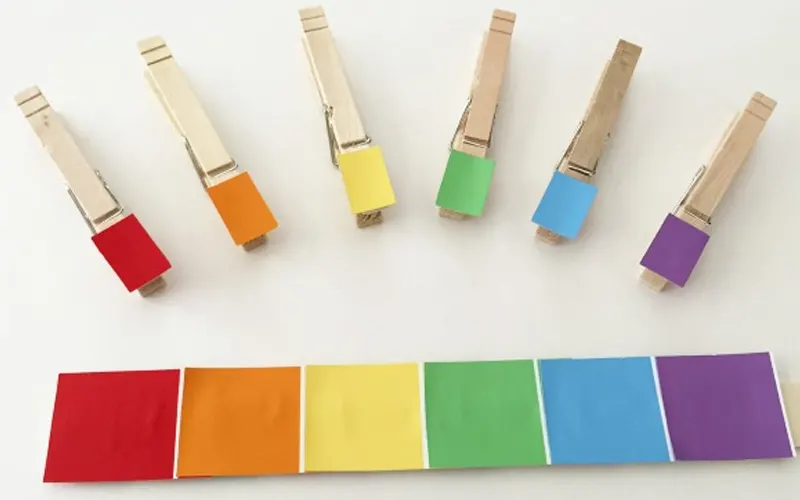
Bahan:
- Wooden or plastic clothespins
- Color cards, flashcards, or printed images
- Tray or shallow container
Preparation:
Prepare clothespins by coloring or labeling them to match the cards (e.g., red pin matches red circle card). Set up the tray with several matches ready to go.
Tangga:
- Demonstrate how to open and close a clothespin using thumb and finger.
- Present one card at a time and ask the child to find and clip the matching pin.
- Allow them to clip along the card’s edges or attach to a string display.
- Rotate matching tasks by category: colors, shapes, numbers, animals.
- Store pins and cards for repeated use.
Creative:
Older children can design their own matching cards or create pattern sequences using multiple clips. Try using numbered pins for counting games or words for sight word recognition.
Nilai Pendidikan:
This task strengthens the pincer grasp and finger isolation, which are crucial for pencil and scissor control. It encourages visual matching, categorization, and one-to-one correspondence. The repeated open-close motion also builds hand stamina and precision for self-care tasks like dressing.
14. Playdough Tool Sculpting
Children use a variety of small tools to press, roll, cut, and shape playdough into different forms. The tactile experience of working with dough offers rich sensory feedback, while the use of tools requires coordinated hand movements and pressure control. Whether they’re flattening dough with a roller or pressing shapes with a stamp, this activity combines imagination with strength-building in a low-pressure way.
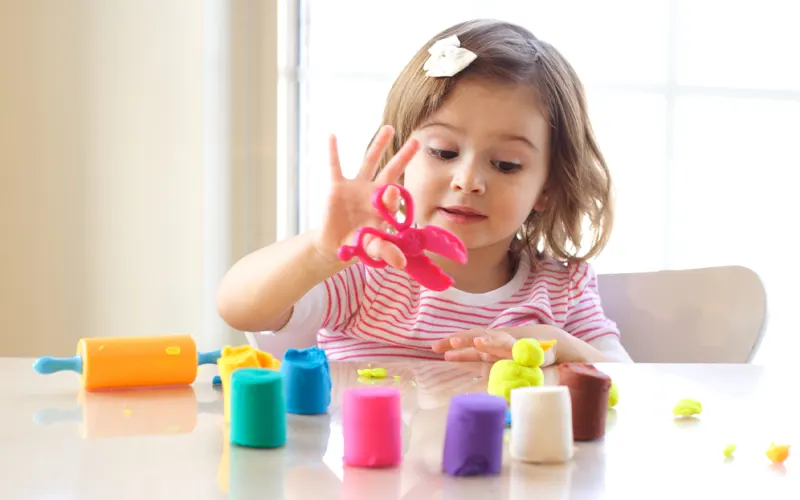
Bahan:
- Playdough (store-bought or homemade)
- Playdough tools: small rolling pins, plastic knives, cookie cutters, stamps
- Tray or plastic mat to contain the mess
Preparation:
Set up a play station with a mat or tray, and arrange the tools and playdough nearby. If homemade dough is used, ensure it’s soft and pliable.
Tangga:
- Allow the child to explore the texture of the dough by squeezing and rolling it.
- Introduce tools one at a time, demonstrating how to press, roll, or cut.
- Encourage them to create objects, letters, or patterns.
- Mix in imaginative prompts like “make your favorite food” or “build a zoo.”
- After the session, store dough in an airtight container.
Creative:
Challenge older kids to recreate real-world objects (like animals, furniture, or vehicles) or follow playdough task cards with step-by-step building prompts. Use natural items like sticks, leaves, or shells to add texture.
Nilai Pendidikan:
This activity builds intrinsic hand strength, finger coordination, and bilateral use. It enhances sensory awareness and pressure modulation. Using different tools promotes grip experimentation, which transfers directly to pencil handling. It also nurtures creativity and verbal expression as children describe their creations.
15. Button Board Challenge
Children practice buttoning and unbuttoning felt or fabric shapes attached to a board using real buttons and buttonholes. The repetitive practice of this self-care motion gives them confidence and competence in daily routines. Buttoning requires a complex sequence of grip, alignment, and finger movement—making it a powerful fine motor workout disguised as a playful task.
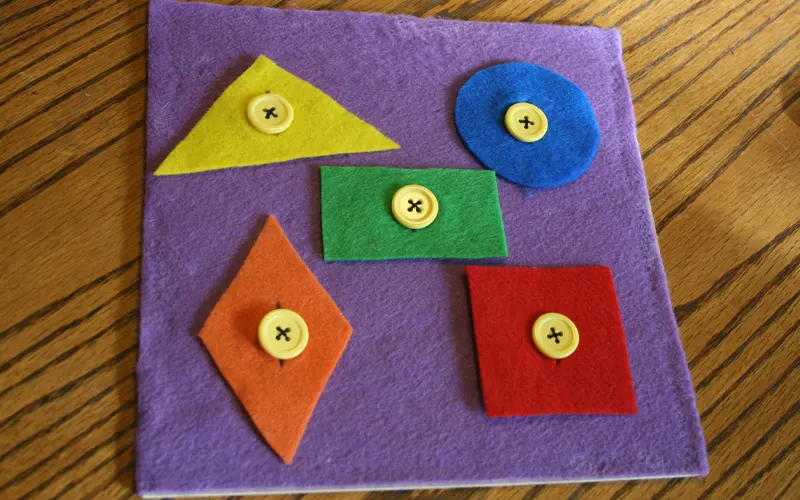
Bahan:
- Sewn-on buttons in various sizes
- Felt shapes (shirts, flowers, animals, etc.) with buttonholes
- Sturdy board or fabric strip
Preparation:
Attach buttons to the board or strip. Prepare felt pieces with reinforced buttonholes that fit securely over the buttons. Ensure sizes are appropriate for small hands—start with larger buttons for beginners.
Tangga:
- Show the child how to push the button through the hole slowly.
- Let them remove and re-button the felt shapes in different combinations.
- Offer themed boards (e.g., dress the snowman, build a flower).
- Encourage repetition to build fluency.
- Gradually introduce smaller buttons as they progress.
Creative:
Turn it into a timed challenge—set a 1-minute timer and see how many buttons the child can fasten or unfasten before the buzzer. You can alternate between buttoning and unbuttoning rounds. For an added twist, mix felt pieces of different colors and ask them to button only the blue ones or build a sequence (e.g., “button red, yellow, blue”).
Nilai Pendidikan:
This activity targets bilateral coordination and hand strength. It builds finger agility and sequential motor planning. It also boosts self-care independence, confidence, and real-world readiness—especially in dressing skills. Matching button sizes with buttonholes promotes judgment and spatial awareness.
16. Sensory Bin Tweezers Pick-Up
Children use child-safe tweezers to find and pick up small items hidden in a sensory bin filled with rice, beans, or shredded paper. This engaging activity blends tactile exploration with focused fine motor practice. Kids enjoy the hunt for hidden treasures and the satisfying task of gripping and lifting them out with precision.
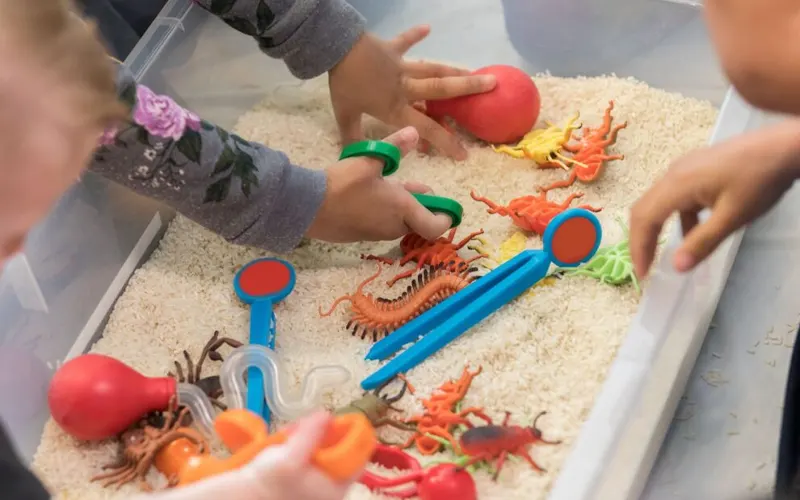
Bahan:
- Empty bowl or tray for collected items
- Sensory bin (tray or plastic box)
- Dry filler (rice, beans, pasta, shredded paper, etc.)
- Child-safe tweezers
- Small objects (mini animals, buttons, pom-poms, erasers)
Preparation:
Fill the sensory bin with the dry material and hide small items throughout. Place tweezers and an empty container beside the bin. Avoid overfilling to keep visibility manageable for younger children.
Tangga:
- Demonstrate how to hold and squeeze tweezers properly.
- Invite the child to search through the sensory bin using only the tweezers.
- Once they find an item, have them transfer it into the collection bowl.
- Encourage them to find all items, name them, or sort them by type or color.
- Change the objects or filler material to keep the activity fresh over time.
Creative:
For older kids, use a sand timer and challenge them to find a specific number of items within a time limit. Introduce categories (“find all animals” or “only green items”) or blindfold versions for added sensory challenge.
Nilai Pendidikan:
This activity strengthens the pincer grasp and finger control necessary for writing, tying, and cutting. It builds hand-eye coordination and object discrimination. The tactile experience stimulates sensory processing, and the sorting or categorizing extensions introduce early math and cognitive reasoning.
17. Nut and Bolt Twist
Children twist plastic or real nuts and bolts together, using both hands in a coordinated motion to align and secure the pieces. The twisting movement is perfect for developing wrist rotation and hand stability. This practical, tool-based task mimics real-world object manipulation, making it particularly exciting for children who enjoy building or mechanical play.
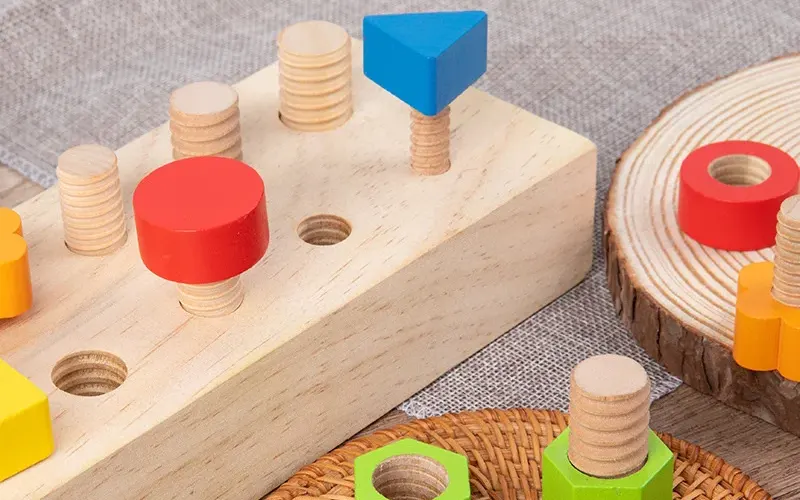
Bahan:
- Plastic or child-safe nuts and bolts (or large real ones if safe and supervised)
- Tray or container to hold pieces
- Optional: sorting cups for organizing by size or color
Preparation:
Sort and display nuts and bolts with matching threads. Demonstrate how to align them and twist. If using real bolts, ensure they are free of sharp edges and cleaned thoroughly.
Tangga:
- Show the child how to hold the bolt steady with one hand and twist the nut with the other.
- Let them try independently, offering support with alignment if needed.
- Once secure, have them untwist and repeat with different pairs.
- Encourage organizing by size, color, or speed.
- Clean and store for future sessions.
Creative:
Older children can complete nut-and-bolt “assembly races” with timers, build shapes using bolts as connectors, or match by thread size for added difficulty.
Nilai Pendidikan:
This task improves wrist stability and rotational control—essential for writing and dressing (e.g., turning a doorknob or fastening a lid). It strengthens bilateral coordination and promotes logical matching. The real-world relevance of nuts and bolts adds an element of practical life skills and STEM familiarity.
18. Lacing Card Designs
In this classic pre-sewing activity, children use shoelaces or yarn to thread through holes in sturdy lacing cards. The repetitive motion of inserting the lace, pulling it through, and aiming for the next hole builds essential coordination. The process is quiet, meditative, and satisfying, making it a great activity for transitions or quiet corners in a classroom or home
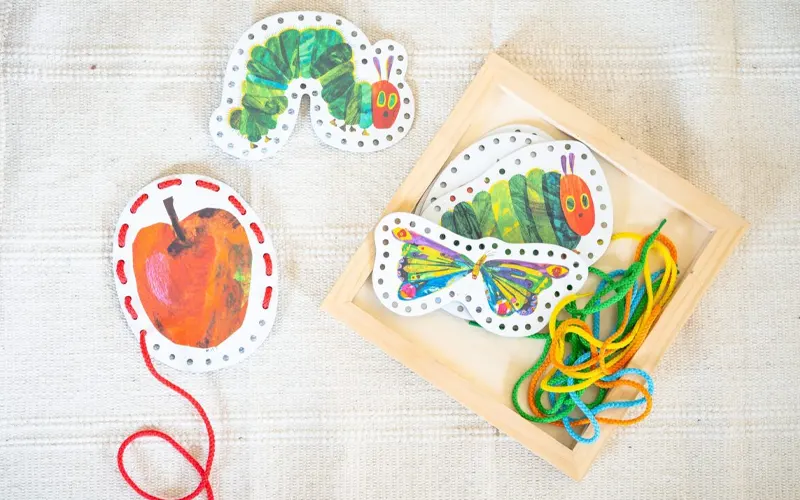
Bahan:
- Lacing cards (store-bought or homemade using cardboard)
- Shoelaces, yarn, or plastic laces (with taped ends)
- Hole punch or pre-punched holes
- Optional: themed shapes (animals, vehicles, letters)
Preparation:
If making your own, cut shapes from sturdy cardboard and punch evenly spaced holes around the edges. Use shoelaces or yarn with firm tips for easier threading.
Tangga:
- Show the child how to insert the lace through the first hole and pull it through.
- Guide them to continue threading around the shape, following the hole pattern.
- Let them try different lacing directions—forward, backward, crisscross.
- Offer new card designs or color challenges to maintain engagement.
- Store cards and laces together for repeated use.
Creative:
Introduce a “lacing challenge” by setting a timer—how many holes can they lace in 2 minutes? For advanced learners, use cards with number or alphabet shapes and have them lace in order.
Nilai Pendidikan:
This activity promotes bilateral coordination, hand dexterity, and fine precision. It strengthens hand muscles used for pencil grip and scissors. The planning required to loop and adjust helps develop sequencing and direction-following skills. Lacing also supports visual tracking, an early literacy and reading readiness skill.
19. Spray Bottle Color Mixing
Children use spray bottles to apply colored water to paper, watching the colors mix and overlap as they squeeze. The squeezing motion is excellent for strengthening hand muscles and building endurance. This is a playful and visually engaging way to combine art with purposeful hand control, and it’s especially enjoyable in warm outdoor settings.
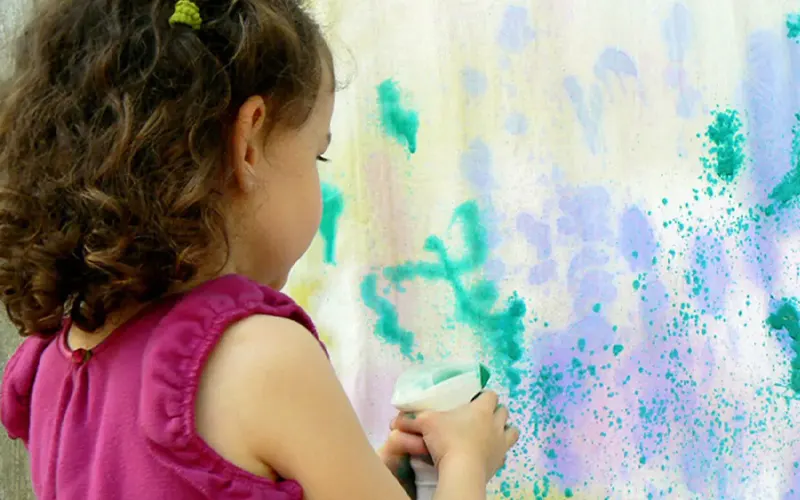
Bahan:
- Small spray bottles
- Water tinted with food coloring or watercolor
- Large sheets of paper (easel or butcher paper)
- Outdoor surface or waterproof mat
Preparation:
Fill spray bottles with different colored water. Tape paper to a fence, easel, or wall. Make sure the bottles are small and easy to squeeze for little hands.
Tangga:
- Show the child how to aim and spray onto the paper surface.
- Let them experiment with layering colors or targeting specific spots.
- Encourage pattern spraying or color mixing (e.g., blue + yellow = green).
- Offer a new paper once the first is full or too wet.
- Allow art to dry and display as vibrant “spray paintings.”
Creative:
Introduce stencils or masking tape designs on the paper so kids can reveal shapes after spraying. Older children can create “spray bottle murals” or spray inside drawn outlines for coloring practice.
Nilai Pendidikan:
This activity builds hand strength, finger endurance, and wrist stability through repeated squeezing. It supports pressure regulation and hand-eye coordination. Visual experimentation with color promotes creativity, early science concepts, and attention to process over product.
20. Ice Cube Transfer with Spoon
Using a spoon, children scoop and transfer slippery ice cubes from one container to another. The cool temperature and slick texture add sensory appeal and challenge, requiring steady hands and focus. It’s a simple but effective way to build spoon control, often a stepping stone to successful eating and pouring skills.
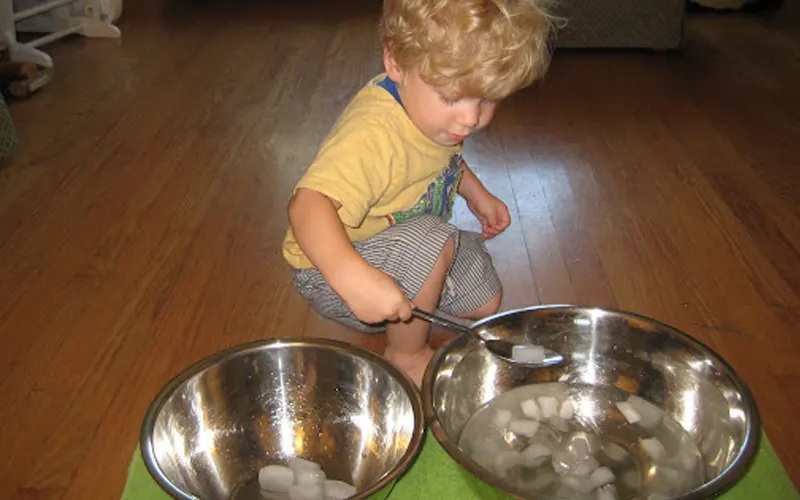
Bahan:
- Ice cubes (colored optional)
- Spoon (child-sized)
- Two bowls or containers
- Towel or waterproof mat for spills
Bahan:
- Ice cubes (colored optional)
- Spoon (child-sized)
- Two bowls or containers
- Towel or waterproof mat for spills
Preparation:
Fill one bowl with a few ice cubes and place an empty bowl nearby. Set the activity on a tray or towel to contain water as ice melts.
Tangga:
- Demonstrate how to scoop an ice cube and carefully transfer it.
- Encourage the child to go slowly and avoid tipping the spoon.
- Let them transfer all cubes from one bowl to the other.
- Repeat with variations like time trials or “no hands” rules.
- Add more ice as needed or offer smaller spoons for challenge.
Creative:
Older children can race against a timer, transfer by color (if dyed), or do relays by walking with the spoon. Try shaped ice molds (stars, hearts) for added interest.
Nilai Pendidikan:
This activity improves spoon grip, hand stability, and bilateral coordination. The shifting, melting texture of ice introduces sensory regulation and requires adaptive control. It supports real-life skills like self-feeding and pouring, essential for independence.
21. Pegboard Design Patterns
Children press small pegs into a perforated pegboard to create designs, lines, or pictures. The simple action of aligning and pressing pegs strengthens fine motor precision while also encouraging creativity and visual planning. This is a calm, focused task ideal for early mornings or transition times in a classroom.
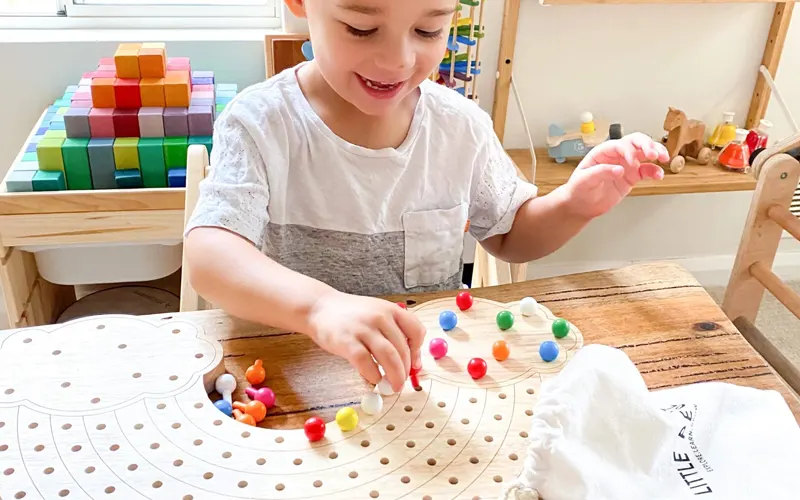
Bahan:
- Child-friendly pegboard
- Colorful plastic pegs
- Optional: design cards or templates
Bahan:
- Child-friendly pegboard
- Colorful plastic pegs
- Optional: design cards or templates
Preparation:
Set up a clean pegboard with a container of colorful pegs. If using templates, print simple pictures (flowers, letters, numbers) for matching.
Tangga:
- Show how to grip and press a peg into the board.
- Let the child explore freely or follow a design.
- Encourage them to create rows, shapes, or patterns.
- Remove and reset pegs to repeat the activity.
- Store pegs in a labeled bin for easy cleanup.
Creative:
Older children can follow more complex templates or invent their own symbols or pixel-style images. Introduce a “guess what I made” game or create color-coded instructions (e.g., red-green-red).
Nilai Pendidikan:
Pegboards build pincer strength, hand-eye coordination, and spatial reasoning. The design component supports early math concepts like symmetry, patterning, and sequencing. Planning and executing a design from start to finish promotes task persistence and pride in work.
22. Paper Clip Chain Building
Children link paper clips together to form long chains, experimenting with color patterns and lengths. This simple activity targets hand strength and coordination as kids align and snap pieces into place. It’s quiet, satisfying, and surprisingly effective for strengthening small finger muscles.
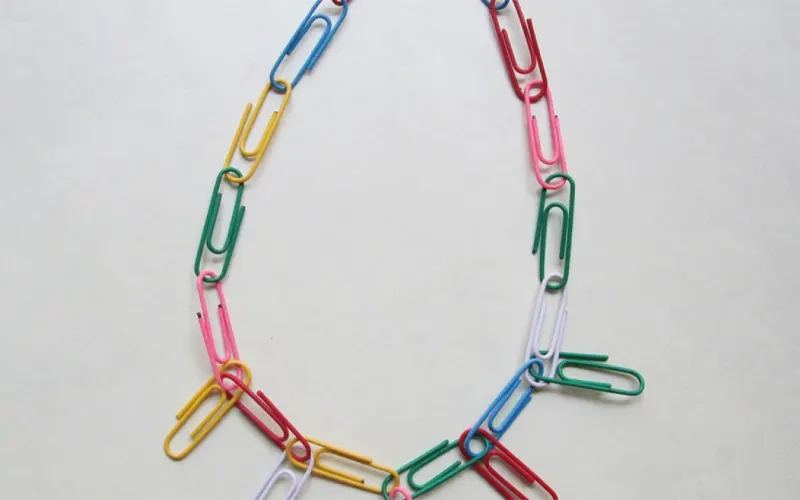
Bahan:
- Paper clips (colorful plastic-coated or metal)
- Small tray or shallow bowl
- Optional: ruler or measuring tape
Preparation:
Gather a variety of paper clips, including different colors or sizes to allow for pattern-building. Plastic-coated clips are easier for small hands to grip and provide visual variety. Place clips in a shallow container or tray to prevent scattering. Demonstrate the linking technique slowly, showing how one clip slides into the end loop of another. Optionally, prepare a ruler or measuring tape for kids who want to track the length of their chains.
Tangga:
- Demonstrate the linking motion—holding one clip steady and threading the other through.
- Encourage the child to build a long chain, working slowly and steadily.
- Introduce pattern-building using clip colors.
- Measure chain length or try to beat their previous record.
- Disassemble and rebuild for repeat practice.
Creative:
Older kids can use chains to form letters, spell names, or create a wearable bracelet. Try a “who can build the longest chain in 3 minutes?” challenge.
Nilai Pendidikan:
This activity strengthens fine motor control, bilateral coordination, and finger isolation. The linking motion builds precision and timing. Color patterning introduces early math, while measuring promotes STEM exploration in a playful context.
23. Rice Writing Tray
Children use their fingers or a blunt tool to trace letters, shapes, or drawings in a shallow tray filled with rice. The tactile sensation makes writing more engaging, especially for reluctant learners. This sensory-rich experience is calming and excellent for practicing strokes without pressure to be “perfect.”

Bahan:
- Shallow tray or baking dish
- Dry rice (plain or colored)
- Printed letter/shape cards (optional)
- Stylus or paintbrush for variety
Preparation:
Choose a shallow tray or plastic lid with raised edges to keep rice contained. Pour in just enough rice to cover the base—about 1/4 inch thick is ideal. If desired, dye the rice beforehand using food coloring and vinegar for visual appeal (let it dry completely). Print large letters, numbers, or shape cards for tracing reference. Set up a damp cloth nearby for easy finger cleanup and place everything on a washable or covered surface.
Tangga:
- Invite the child to draw a line, shape, or letter in the rice with their finger.
- Smooth the rice to reset the surface between tries.
- Introduce cards for reference if needed.
- Let them experiment with tools like brushes or cotton swabs.
- Encourage them to say the letter or shape name as they draw.
Creative:
Older children can write sight words, create scenes, or write in different textures (e.g., salt, cornmeal). Try “guess the letter” games between partners for variety.
Nilai Pendidikan:
Rice writing builds tactile sensitivity and stroke control. It supports finger isolation and directionality, both essential for letter formation. The repetition strengthens muscle memory, and the sensory input enhances focus and emotional regulation.
24. Magnetic Wand and Chips Maze
Children use a magnetic wand to move magnetic chips or discs through a maze drawn on a tray or placed under clear plastic. The pulling motion builds wrist control and hand steadiness, while the invisible magnetic interaction keeps kids engaged. This quiet game encourages focus and problem-solving while promoting core fine motor skills.
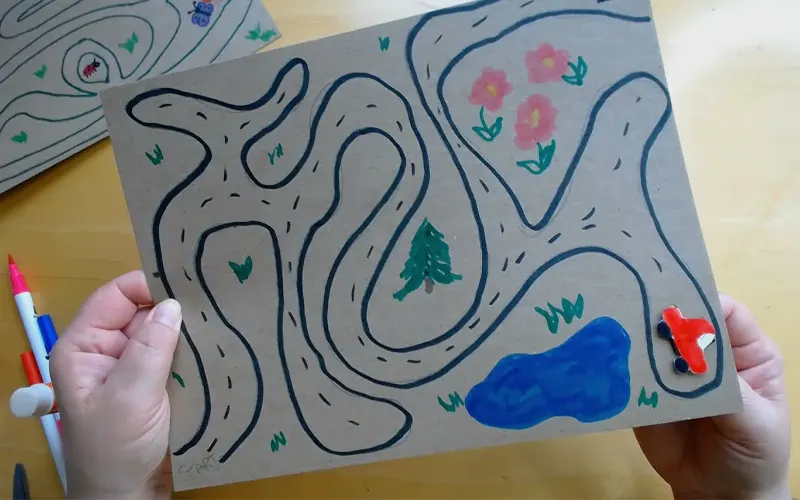
Bahan:
- Magnetic wand
- Magnetic chips or paper clips
- Plastic tray or box lid
- Maze printout or hand-drawn path
- Clear plastic cover or laminator sheet (optional)
Bahan:
- Magnetic wand
- Magnetic chips or paper clips
- Plastic tray or box lid
- Maze printout or hand-drawn path
- Clear plastic cover or laminator sheet (optional)
Preparation:
Draw or print a maze on a piece of paper and tape it to the tray. If available, cover it with a clear plastic sheet for durability. Place magnetic chips at the starting point. Test the strength of the magnet to ensure it works smoothly under the cover.
Tangga:
- Show the child how to hold the magnetic wand just above or below the chips.
- Guide the chip along the maze by gently pulling it with the wand.
- Encourage slow, controlled movement to stay on the path.
- Let them complete the maze and reset for another round.
- Offer varied maze designs to maintain challenge.
Creative:
Introduce multiple chips for a race or “collect the coin” challenge. Older children can design their own mazes or use the wand to sort colored chips into matching zones.
Nilai Pendidikan:
This activity strengthens wrist and arm stability, visual-motor coordination, and fine precision. It builds patience and strategic planning as children navigate obstacles. The invisible force of the magnet introduces basic science concepts while engaging attention and persistence.
25. Sponge Squeeze and Transfer Water
Children soak and squeeze sponges to transfer water between two containers. This classic water play activity strengthens hand muscles while providing soothing sensory input. The repeated action of squeezing and releasing helps build the same muscles used for gripping and writing.
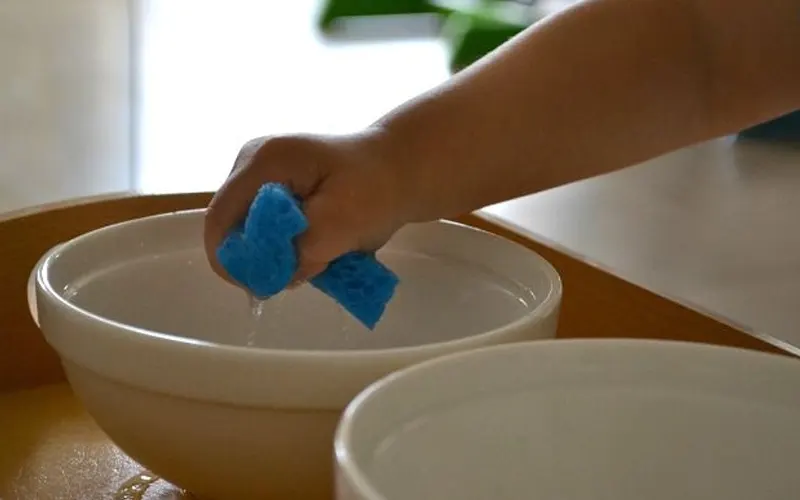
Bahan:
- Clean household sponges
- Two bowls or containers
- Water (optionally colored with food dye)
- Towel or tray for mess control
Preparation:
Place one bowl with water and one empty bowl on a waterproof mat or tray. Cut sponges into palm-sized chunks that are easy for small hands to squeeze. Optionally, color the water with a drop of food dye to make the activity more visually interesting.
Tangga:
- Demonstrate how to dip the sponge into the water and squeeze it into the empty bowl.
- Let the child repeat the motion at their own pace.
- Encourage them to fill the empty bowl completely.
- Offer more sponges or bowls for longer engagement.
- Wipe hands dry after or transition to a calm-down activity.
Creative:
Older children can race against a timer, transfer water by color, or measure how many squeezes it takes to fill a container. Add math challenges like “Can you squeeze exactly five spoonfuls?”
Nilai Pendidikan:
This activity strengthens grip, palm compression, and hand stability. It builds bilateral coordination and enhances sensory regulation through tactile feedback. The movement also improves pressure control, aiding in pencil grasp and scissor cutting precision.
26. Button Sorting with Muffin Tin
Children use their fingers or tweezers to sort buttons into muffin tin compartments by size, color, or shape. The task blends categorization with fine motor control, offering a focused yet playful way to build precision. It’s easy to set up, adaptable to skill levels, and perfect for quiet play.
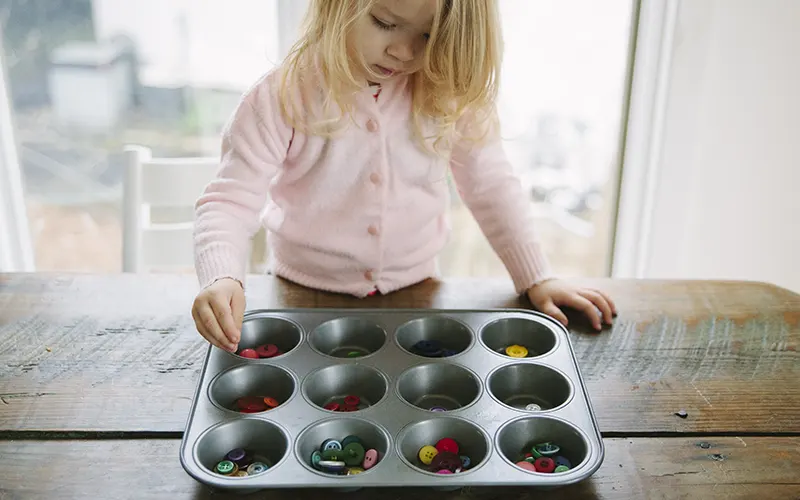
Bahan:
- Assorted buttons (various sizes, shapes, and colors)
- Muffin tin or egg carton
- Child-safe tweezers or tongs (optional)
- Sorting chart or labels (optional)
Preparation:
Gather a variety of buttons and check they’re safe (large enough to avoid choking). Place them in a bowl. Label each muffin tin compartment with a color or shape, or leave it open-ended for exploratory sorting. Place tweezers nearby if offering that challenge.
Tangga:
- Introduce the buttons and show how to sort by one attribute (e.g., color).
- Let the child sort by hand or with tweezers into each muffin compartment.
- Change the sorting rule once they’ve finished (e.g., switch to size).
- Encourage verbal description of what they see and sort.
- Store buttons and tin together for repeat use.
Creative:
Older children can create sorting rules themselves, or guess “what’s my rule” if you start sorting first. Introduce math extensions like graphing or counting totals in each cup.
Nilai Pendidikan:
This activity sharpens the pincer grasp and supports wrist rotation during picking and placing. It enhances visual discrimination and classification—early math and logic skills. Verbalizing sorting strategies supports cognitive flexibility and descriptive language development.
27. Q-Tip Painting Dots
Children dip cotton swabs (Q-tips) in paint and create pictures or patterns by dotting them onto paper. This simple yet effective art activity encourages controlled movement, finger isolation, and focus. The repetitive dotting motion is quiet, relaxing, and highly adaptable to themed lessons.
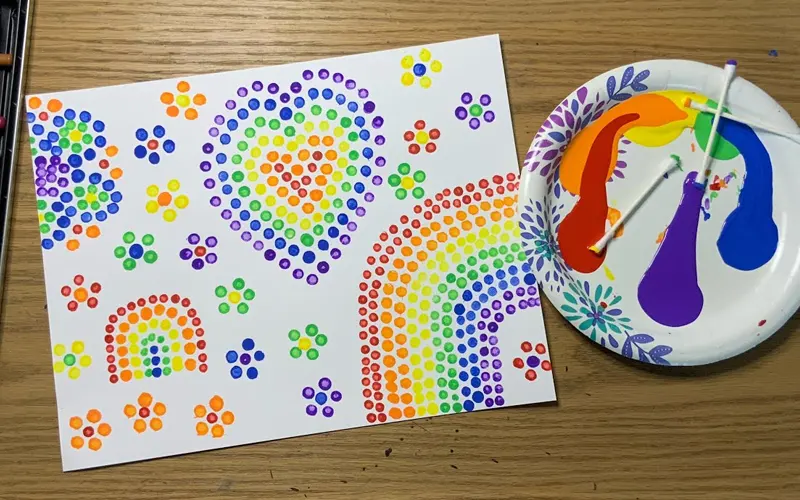
Bahan:
- Cotton swabs
- Washable paint in small containers
- Paper (white or colored)
- Apron and table covering
Bahan:
- Cotton swabs
- Washable paint in small containers
- Paper (white or colored)
- Apron and table covering
Preparation:
Prepare a paint station with small blobs of paint in separate cups or trays. Lay out paper and cover surfaces as needed. Demonstrate the light dotting motion to avoid over-smearing.
Tangga:
- Show how to dip a Q-tip lightly into the paint and dot it on the paper.
- Let the child explore by making lines, shapes, or pictures with dots.
- Offer templates (e.g., trace a letter with dots) for structured practice.
- Allow them to mix colors or create scenes like fireworks or animals.
- Let artwork dry and save or display.
Creative:
Older children can follow detailed templates, practice writing names in dots, or create pixel-style designs. Try “dot-to-dot” activities they complete in paint instead of pencil.
Nilai Pendidikan:
Dot painting builds finger precision and fine motor control. It reinforces patience and pacing—critical for writing fluency. The action of forming patterns supports early numeracy and visual sequencing. The artistic aspect boosts creativity and confidence.
28. Coin Slot Drop Box
Children drop plastic coins or real coins into narrow slots cut into a box or container lid. This simple but addictive activity develops eye-hand coordination and fine finger control, especially when using smaller coin sizes. It’s a great independent task that feels like a game.
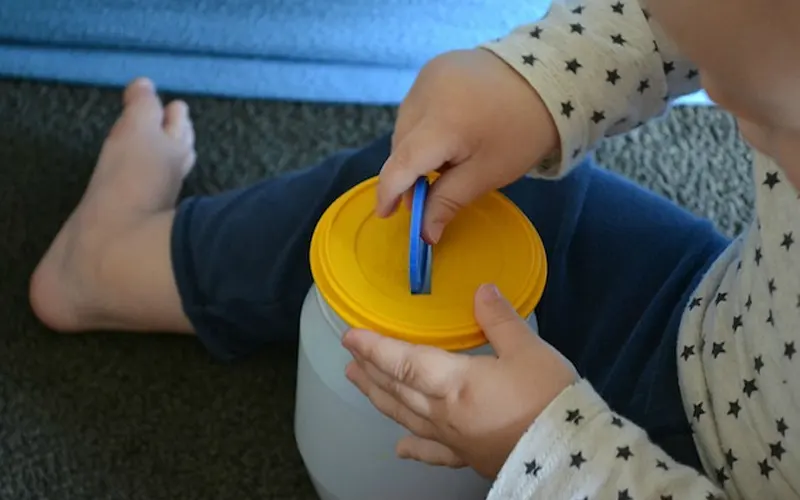
Bahan:
- Recycled container with plastic lid (e.g., coffee tin, oatmeal tub)
- Craft knife or box cutter (adult use only)
- Plastic play coins or real coins (or cardboard discs)
- Optional: slot labels for matching
Bahan:
- Recycled container with plastic lid (e.g., coffee tin, oatmeal tub)
- Craft knife or box cutter (adult use only)
- Plastic play coins or real coins (or cardboard discs)
- Optional: slot labels for matching
Preparation:
Cut one or more coin-sized slits into the lid of a container. Smooth any rough edges and test with coins to ensure the slot is neither too wide nor too tight. Gather coins in a bowl and set everything on a tray.
Tangga:
- Show how to grip a coin with thumb and finger and line it up with the slot.
- Let the child drop coins one by one into the box.
- Add sorting rules (e.g., match the coin to the labeled slot).
- Listen together to the sound the coin makes—kids love the “clink.”
- When finished, open the lid and let them retrieve and repeat.
Creative:
Add numbered slots for older children to sort by value or complete challenges (e.g., “drop 10 coins into slot 3”). Try slanted slots or multiple openings for greater precision.
Nilai Pendidikan:
This task improves pincer grasp, object orientation, and control. It builds persistence and focus through repetition. Matching coins to slots introduces categorization and early money skills. It also strengthens wrist positioning and bilateral hand coordination—core components of school readiness.
29. Pipette Water Measurement
Children use pipettes to transfer colored water between cups or tubes, practicing precise control of suction and release. It’s a fun, science-inspired activity that mixes art and measurement—excellent for building hand strength and precision while exploring volume concepts.
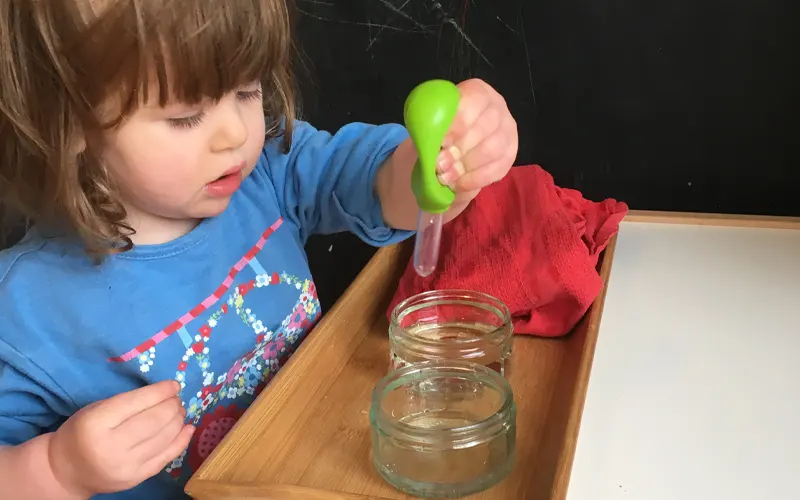
Bahan:
- Plastic pipettes (medicine dropper style)
- Clear cups, small jars, or test tubes
- Water dyed with food coloring
- Measuring charts or counting cups (optional)
Preparation:
Fill cups with different colors of water. Line them up on a tray or table. Provide empty cups or tubes for transfers. If desired, prepare a simple worksheet showing how many drops fill each vessel.
Tangga:
- Demonstrate how to squeeze and release the pipette to pick up liquid.
- Encourage the child to transfer drops into another cup, observing drip counts.
- Offer guidance to steady the hand as water fills the container.
- Allow open-ended transfers or follow a measurement prompt.
- Clean up and refill as needed after each round.
Creative:
Older kids can estimate and record drop counts, mix colors to create new ones, or complete a timed “fill‑the‑cup” challenge. Introduce funnels, graduated cylinders, or pipettes of differing sizes for complexity.
Nilai Pendidikan:
Pipette water measurement enhances pincer strength, hand–eye coordination, and pressure modulation. It supports early STEM skills through counting, measurement, and observation. The sensory aspect builds concentration and fine motor control simultaneously.
30. Popsicle Stick Weaving
Children weave yarn or ribbon up and down between vertical popsicle sticks arranged in a simple loom pattern. This rhythmic motion of threading and looping strengthens coordination and focus. It’s a classic craft that combines creativity with tactile engagement—perfect for quiet, hands‑on concentration.
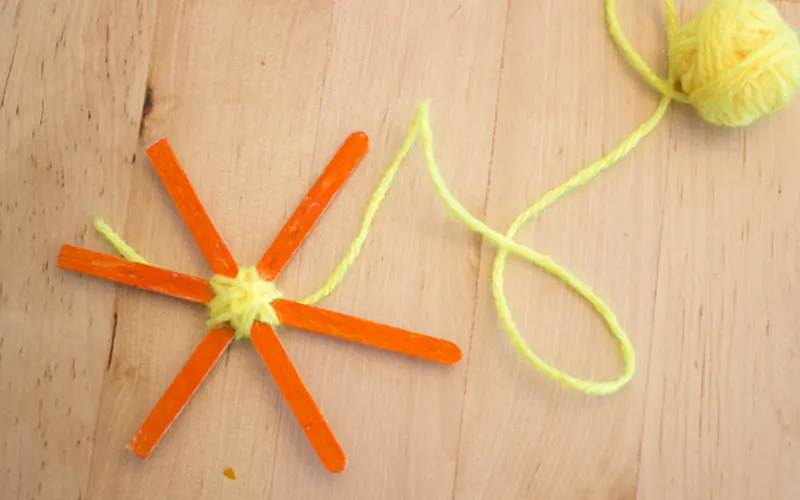
Bahan:
- 8–10 popsicle sticks
- Yarn, string, or thin ribbon
- Stapler or strong tape
- Gunting
Preparation:
Arrange the sticks vertically across a base stick and secure them with tape or by weaving the first horizontal piece. Leave enough space between sticks for weaving. Cut yarn strands about 12–18 inches long, and tie one end to the base stick.
Tangga:
- Demonstrate weaving the yarn over and under alternating sticks.
- Allow the child to continue the pattern until the row is complete.
- Show how to push the yarned row down gently with fingers or a small comb.
- Repeat additional rows, alternating weaving patterns (over‑under, under‑over).
- Tie off the end when the weaving reaches the top.
Creative:
Older children can experiment with color changes, textured yarns, or create shapes/patterns. They can also create small wall hangings or bookmark-style pieces using ribbon or beads between rows.
Nilai Pendidikan:
Popsicle stick weaving promotes bilateral hand use, finger dexterity, and endurance through repetitive threading. It enhances pattern recognition, sequencing, and spatial planning. The tactile feedback builds fine motor precision and encourages sustained concentration.
Fine Motor Activities for Autism
Children with autism often benefit from fine motor activities that are visually structured, sensory-friendly, and clearly defined. These tasks not only support motor development but also promote self-regulation, communication, sequencing, and independence. While the fundamental goals are similar to general fine motor development, the approach is often more scaffolded and predictable to accommodate sensory processing differences and cognitive preferences.
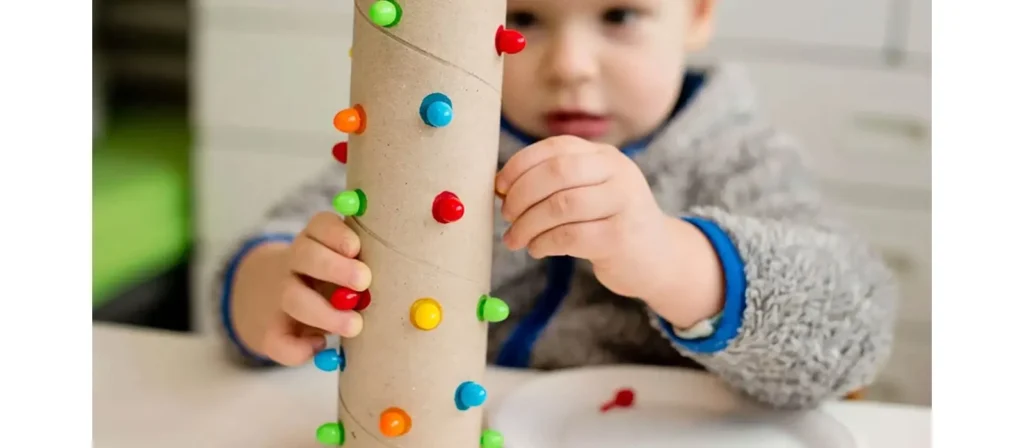
Below is a list of carefully selected fine motor activities for autism, with simple instructions, tactile rewards, and built-in visual structure:
- Matching with Clothespin Strips
Children use labeled clothespins to match pictures or shapes on laminated strips. This builds pincer strength, visual scanning, and matching logic while offering clear start-and-end boundaries. - Push and Pull Bead Strip
Threaded beads are pushed or pulled across a fixed string, reinforcing bilateral coordination and wrist control. The smooth, repetitive movement helps regulate energy and supports fine motor planning. - Visual Schedule Puzzle Board
By peeling Velcro picture cards and placing them in sequence, children work on planning, sequencing, and grasp strength. It reinforces routine understanding and can be adapted for morning checklists or transitions. - Foam Shape Punch and Match
Using a hand punch tool to create foam shapes, then matching them to outlines or shadow boards, children strengthen grip and engage in a satisfying “cause-effect” task with minimal verbal input required. - Sticker Strip Completion
Strips with missing parts (e.g., red–blue–red–__) are completed using matching dot stickers. The controlled placement and visual logic make it a soothing yet cognitively stimulating task. - Sensory Bag Letter Tracing
A sealed sensory bag filled with hair gel and glitter lets children trace letters, shapes, or lines with their finger. The squishy texture offers excellent tactile feedback without the mess of traditional writing. - Spoon and Bowl Sorting with Textures
Children sort textured balls, beans, or pom-poms using a spoon into matching bowls. It builds spoon control, encourages categorization, and provides calming repetitive movement. - Simple Peg Insertion Boards
Large plastic or wooden pegs are inserted into hole boards or foam. It’s a classic but incredibly effective activity for developing finger precision, eye-hand coordination, and task completion. - Velcro Shape Boards
Children peel and re-stick Velcro-backed shapes to matching silhouettes on a board. The tactile satisfaction and simplicity of this task make it especially effective for attention and sensory regulation.
Tips for Supporting Autistic Children in Fine Motor Activities
- Use Visuals: Picture steps or icons can reduce the need for verbal instructions.
- Limit Stimuli: Keep materials simple and cleanly presented to reduce overwhelm.
- Offer Choice: Let the child choose between two or three tasks to increase engagement.
- Honor Repetition: Repeating favorite tasks builds mastery and confidence.
- Build in Predictability: Use trays, start/finish bins, and checklists to provide structure.
Kirimkan pesan kepada kami jika Anda memiliki pertanyaan atau meminta penawaran harga. Pakar kami akan membalas Anda dalam waktu 48 jam dan membantu Anda memilih produk yang tepat sesuai keinginan.
How to Choose the Right Fine Motor Activities for Preschoolers?
Choosing the right fine motor activities for preschoolers means understanding a child’s current abilities, interests, and the specific skills you want to support. The goal is to provide activities that are appropriately challenging, engaging, and aligned with developmental milestones. Let’s explore how to make confident, effective choices when planning fine motor activities for preschoolers.
Observe the Child’s Current Skills and Needs
Start by watching how the child interacts with everyday materials. Are they able to hold crayons with three fingers, or do they still fist-grip? Can they manage small objects like buttons or zippers, or do they struggle with coordination? Observation helps identify the following:
- Grasp type and hand strength
- Finger isolation and dexterity
- Bilateral coordination (using both hands together)
- Visual-motor integration
- Tactile sensitivity or sensory-seeking behavior
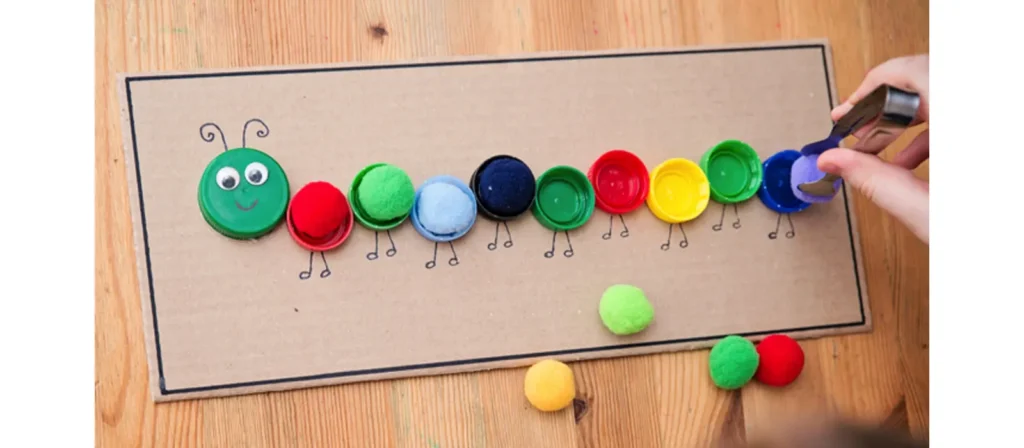
Match Activities to Fine Motor Goals
Every fine motor activity should align with a specific developmental purpose. Simply choosing something entertaining isn’t enough—activities must intentionally build strength, precision, coordination, or functional independence. The clearer your goal, the more effective the activity becomes.
For example, if you’re supporting handwriting readiness, you’ll want tasks that strengthen the fingers and promote proper grasp and control. If you’re preparing a child for daily living skills, focus on activities that mirror real-world tasks like opening containers or fastening buttons.
Every fine motor activity serves one or more of the following purposes:
- Strengthening the hands and fingers
- Improving pencil grip and writing readiness
- Building coordination for tasks like dressing and eating
- Enhancing sensory regulation
- Developing planning and sequencing
Consider Sensory Preferences and Regulation
Sensory comfort plays a big role in how children engage with fine motor play. Some avoid sticky textures or noise, while others seek out deep pressure or movement. Choose materials that suit their preferences, starting with neutral or familiar textures. Matching the activity to their sensory profile keeps them calm, focused, and more willing to participate.
Start Simple and Scaffold Up
Always begin with tasks that have a clear start and end, such as sticker peeling or pom-pom sorting. As children grow more confident, gradually add steps, introduce new tools, or incorporate time-based challenges. This scaffolding approach helps them progress without becoming overwhelmed. It also encourages mastery before moving on to harder skills.
Offer Choice and Encourage Ownership
When children choose their materials or tasks, they feel more invested and engaged. Simple choices like sticker themes or activity order can make them feel in control. This sense of ownership encourages independence and builds intrinsic motivation. It also helps reduce resistance, especially during repetitive skill-building exercises.
Consider Materials You Already Have
Fine motor development doesn’t require expensive tools. Everyday items like cotton balls, clothespins, buttons, paper clips, tongs, or pipe cleaners can be transformed into engaging fine motor tasks. Look for ways to incorporate these into DIY activities or classroom centers.
Use Consistent Routines with Flexibility
A steady routine helps children know what to expect and builds a habit of participation. Schedule fine motor time daily or weekly, using familiar tools or setup trays to create structure. At the same time, introduce small variations to keep it fresh. Flexibility within routine helps adapt to the child’s mood, energy, or sensory needs that day.
Tips for Successful Fine Motor Activities
Planning and implementing fine motor activities for preschoolers and toddlers is more effective when approached with a blend of structure, flexibility, and child-centered thinking. Whether you’re working with an individual child or a group, these tips can help maximize the developmental benefits while keeping the experience fun and stress-free.
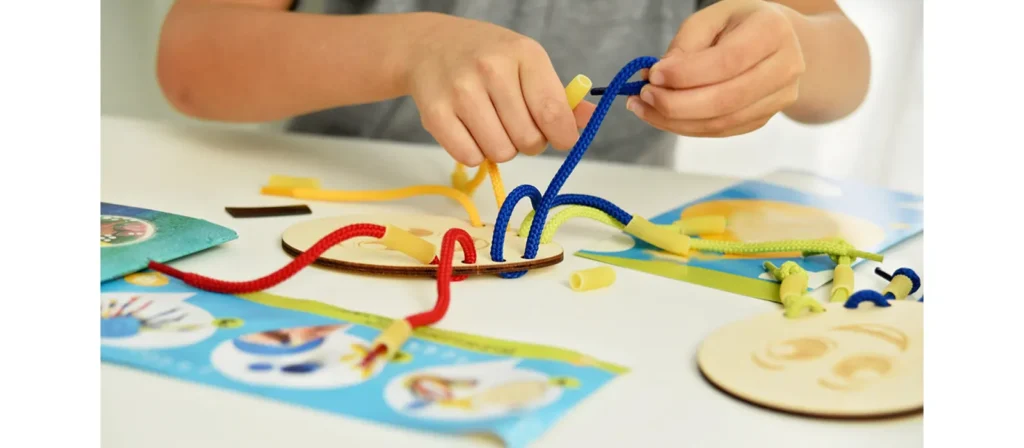
- Demonstrate Clearly and Use Visual Cues
Model each step slowly and clearly, showing how to hold, place, or move materials. Visual aids like arrows, picture cards, or step charts help children follow along. Avoid giving too many verbal instructions at once. Simplicity supports success and reduces anxiety. - Keep Activities Short and Purposeful
Start with brief sessions—5 to 10 minutes is often enough for young children. Focus on completing one goal, such as filling a tray or matching three items. Celebrate effort more than outcome. Building endurance can come later, once confidence has grown. - Balance Familiar Tasks with New Challenges
Repeat successful activities often, then introduce small changes to keep interest high. For example, use different colors, tools, or themes. Familiarity supports mastery, while novelty keeps children engaged. Too many changes at once can cause stress or confusion. - Include Movement Breaks and Whole-Body Tasks
Alternating fine motor work with physical movement helps reset focus and regulate energy. Try animal walks, yoga poses, or simple stretches. These activities prepare the body for steady hand work and reduce restlessness, especially in active or sensory-seeking children. - Always Prioritize Safety and Supervision
Choose materials that are age-appropriate and non-toxic. Avoid small items for children under 3 due to choking risks. Closely supervise activities involving scissors, beads, or tongs. Keep sharp tools and breakable objects out of reach unless directly guided by an adult. - Watch for Frustration and Be Flexible
If a child shows signs of struggle, pause and offer help, or gently shift to something easier. Flexibility encourages persistence and prevents negative associations with learning. Allow children to stop and return later if needed—success is built over time, not in one session.
Right Fine Motor Skills Toys for Toddler and Preschoolers
Choosing the right fine motor skills toys for toddlers and preschoolers can make a big difference in how young children build hand strength, coordination, and control. The best educational toys are those that combine development, safety, and play. They should be engaging, age-appropriate, and designed to strengthen the small muscles in the hands and fingers through repeated use. Here are some top categories of fine motor toys to consider:
1. Stacking and Nesting Toys
- Ring Stacking Towers
Large rings and a central pole help toddlers practice controlled placement and wrist movement. - Stacking Cups
Lightweight, color-coded cups that stack or nest to build grip strength and spatial awareness. - Nesting Boxes
Hollow boxes in descending sizes promote visual discrimination and careful hand alignment.
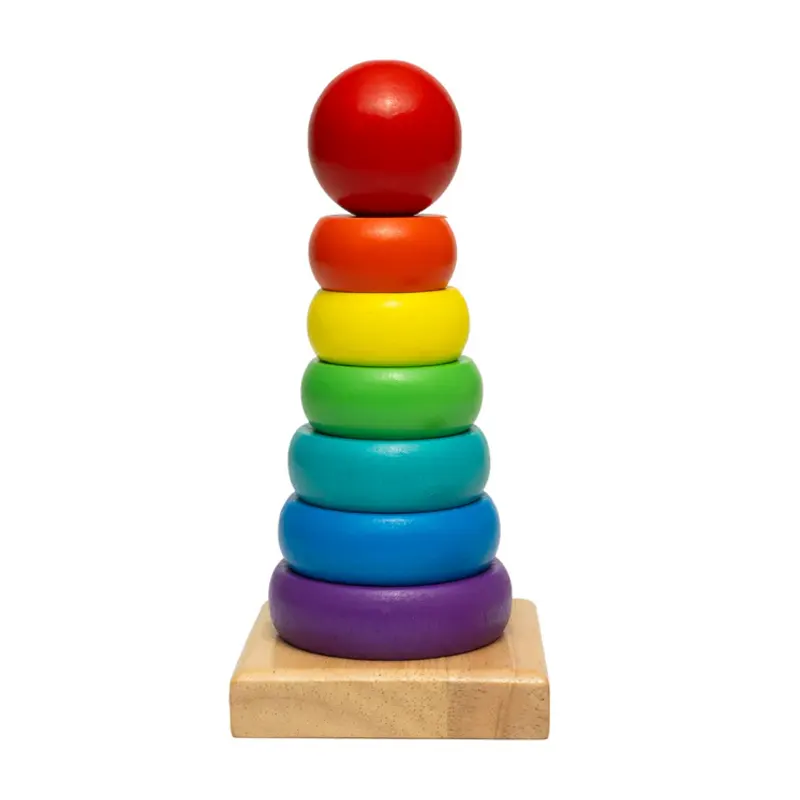
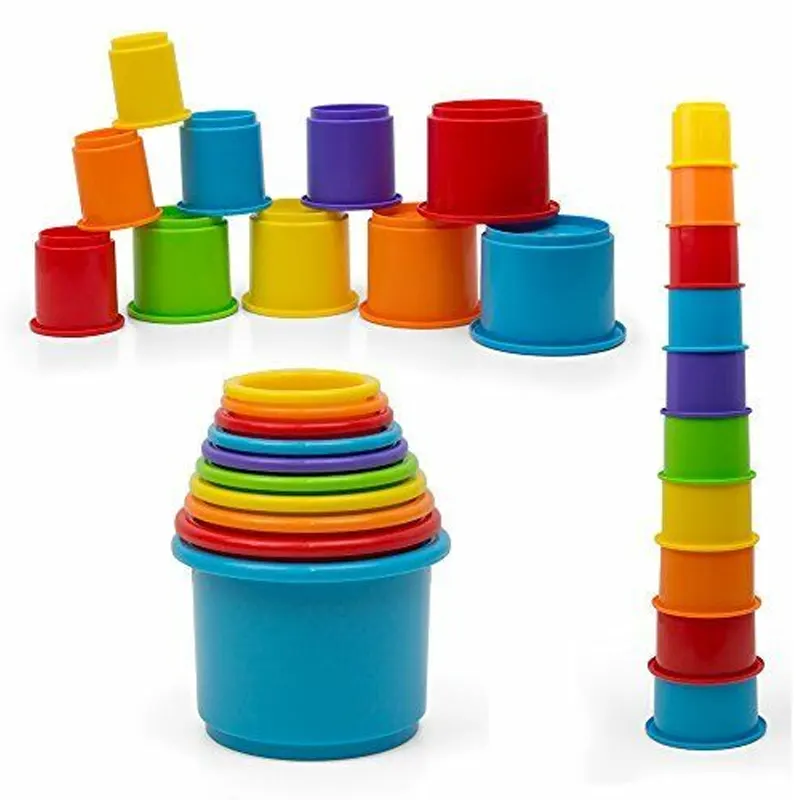
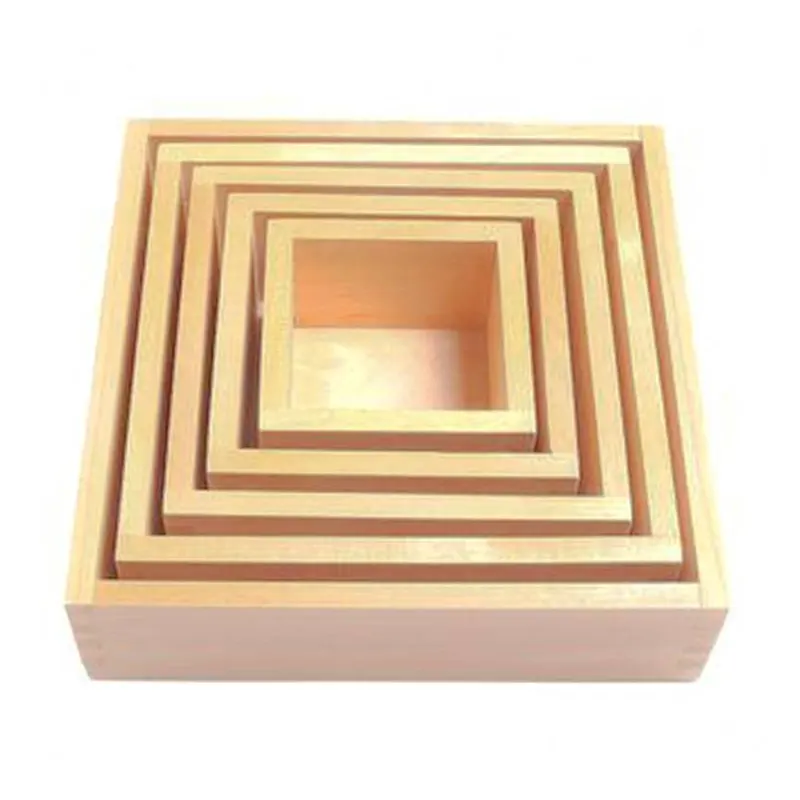
2. Lacing and Threading Toys
- Wooden Lacing Beads
Thick, easy-to-thread beads develop pincer grip and bilateral coordination. - Lacing Cards
Flat shapes with pre-punched holes allow preschoolers to “sew” with yarn or cords. - Shoe-Lacing Practice Boards
Mimic real-world lacing with large holes and thick strings for functional fine motor training.
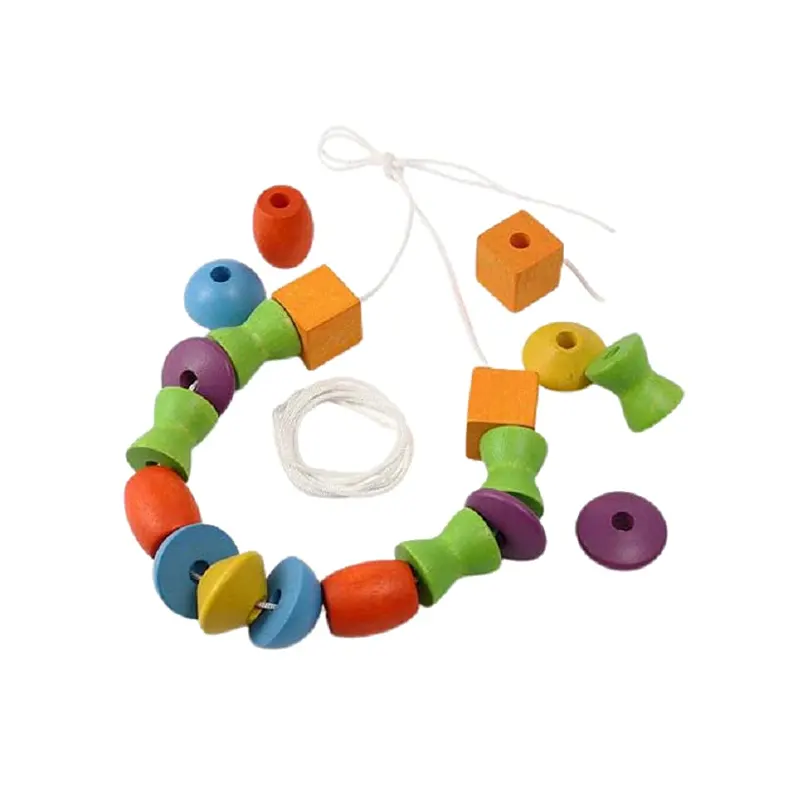
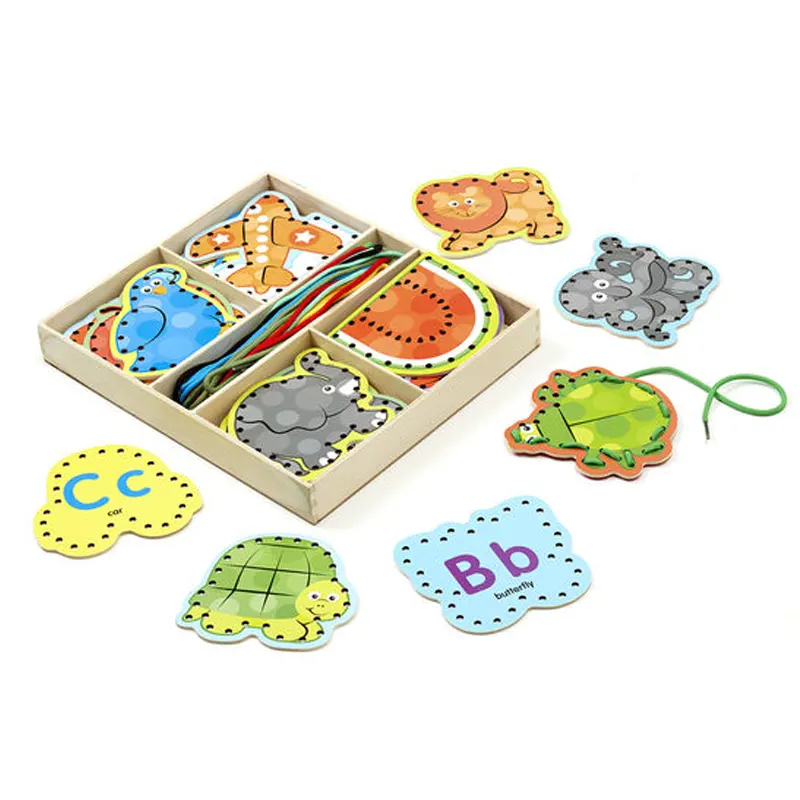
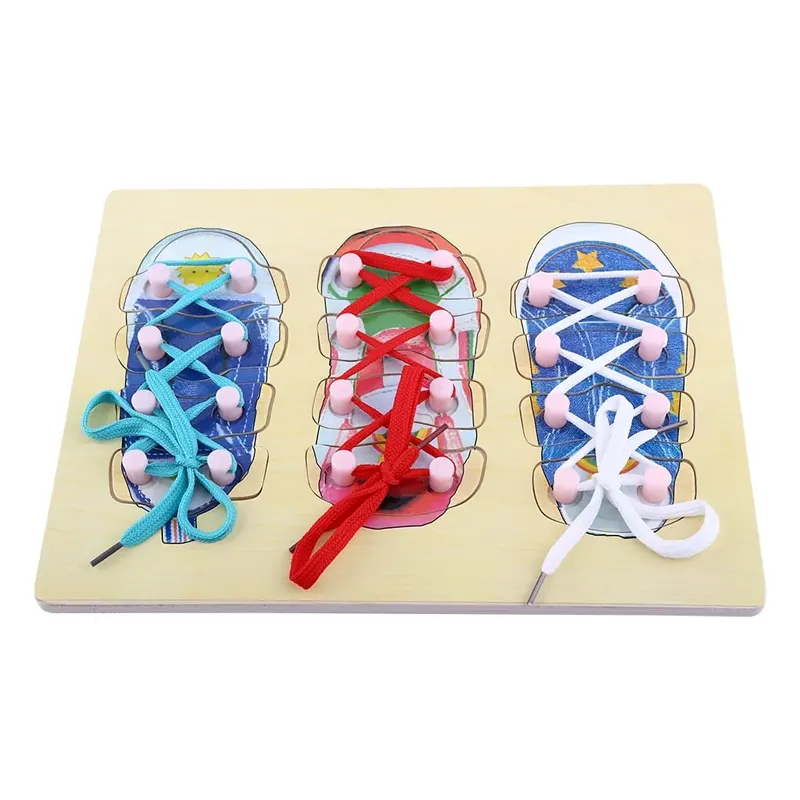
3. Shape Sorters and Peg Boards
- Shape Sorting Cube
Encourage shape recognition and hand rotation to fit pieces into matching slots. - Tall Peg Boards
Children use precision and grasp control to place and stack pegs vertically. - Multi-Shape Sorting Panels
Complex boards requiring comparison of size, form, and orientation improve planning and control.
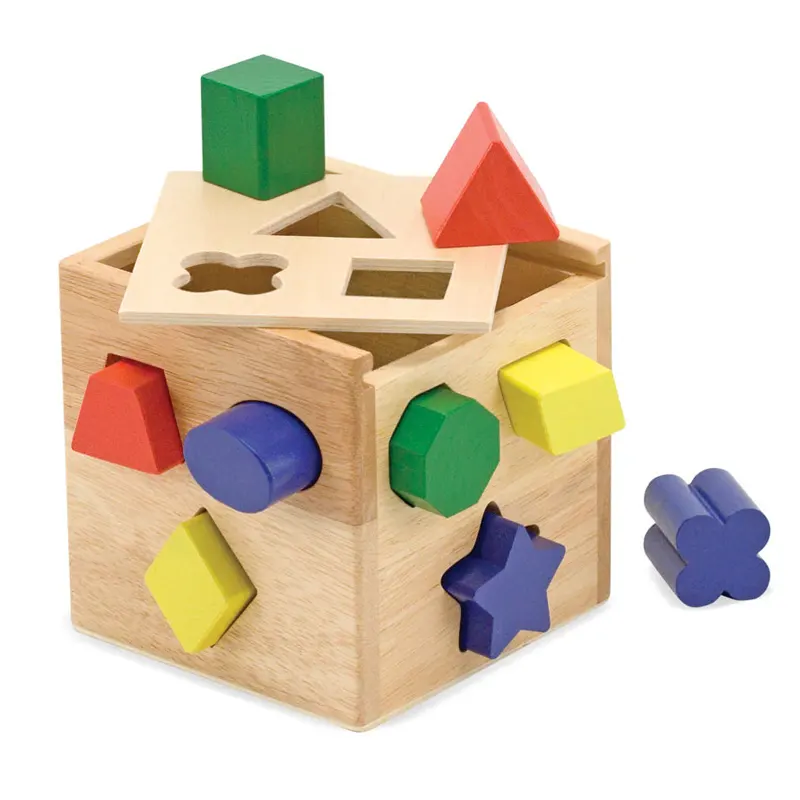
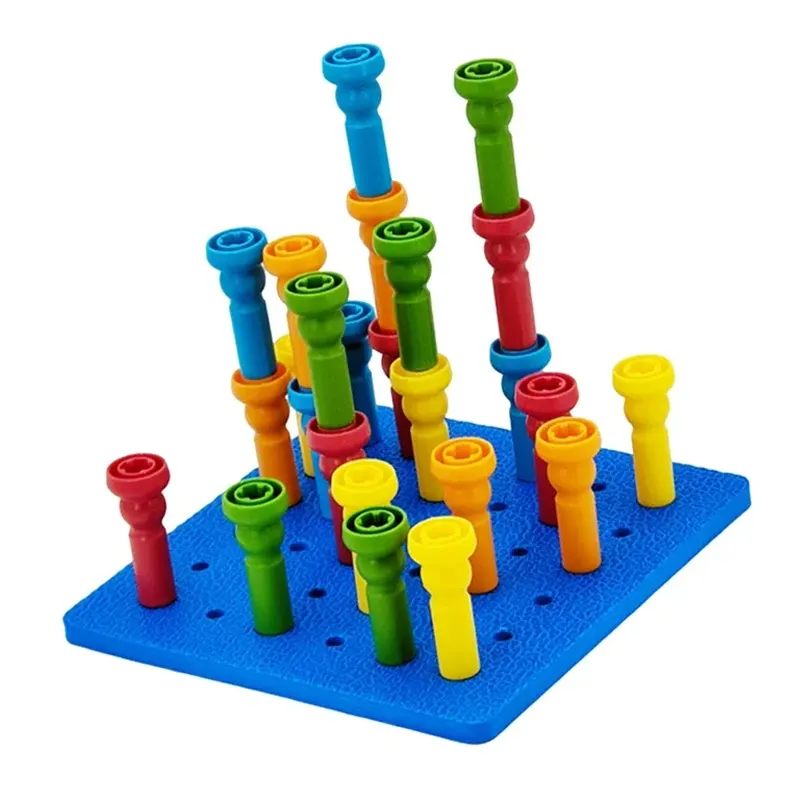
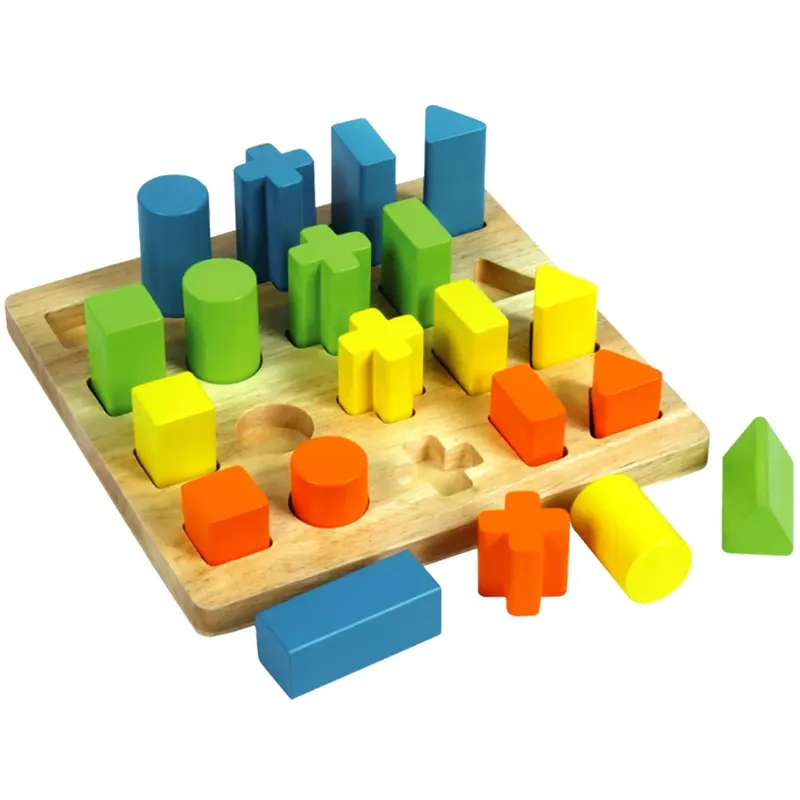
Kirimkan pesan kepada kami jika Anda memiliki pertanyaan atau meminta penawaran harga. Pakar kami akan membalas Anda dalam waktu 48 jam dan membantu Anda memilih produk yang tepat sesuai keinginan.
4. Building Toys and Interlocking Blocks
- Snap-Together Blocks
Require finger pressure and alignment to connect and separate pieces. - Magnetic Tiles
Allow for easier connection while still promoting precise placement and structure stability. - Plastic Nuts and Bolts Sets
Children twist and match threaded components, enhancing grip and wrist rotation.
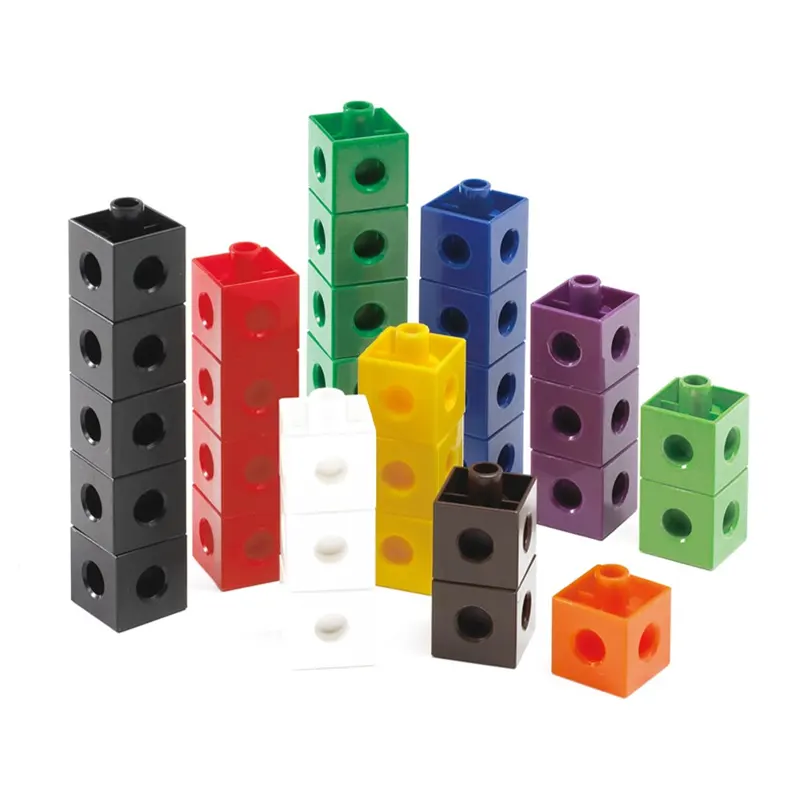
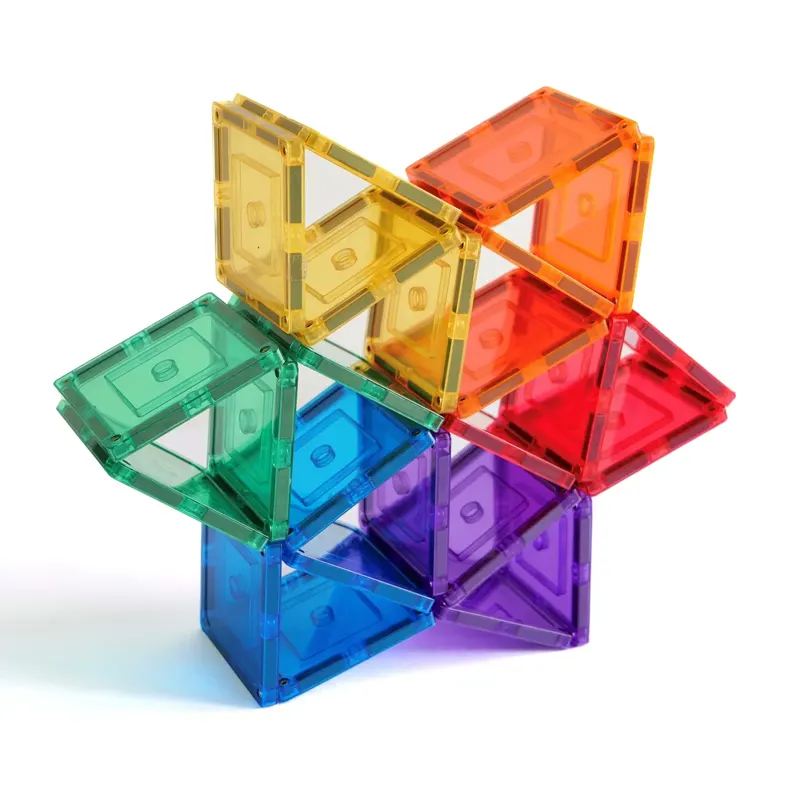
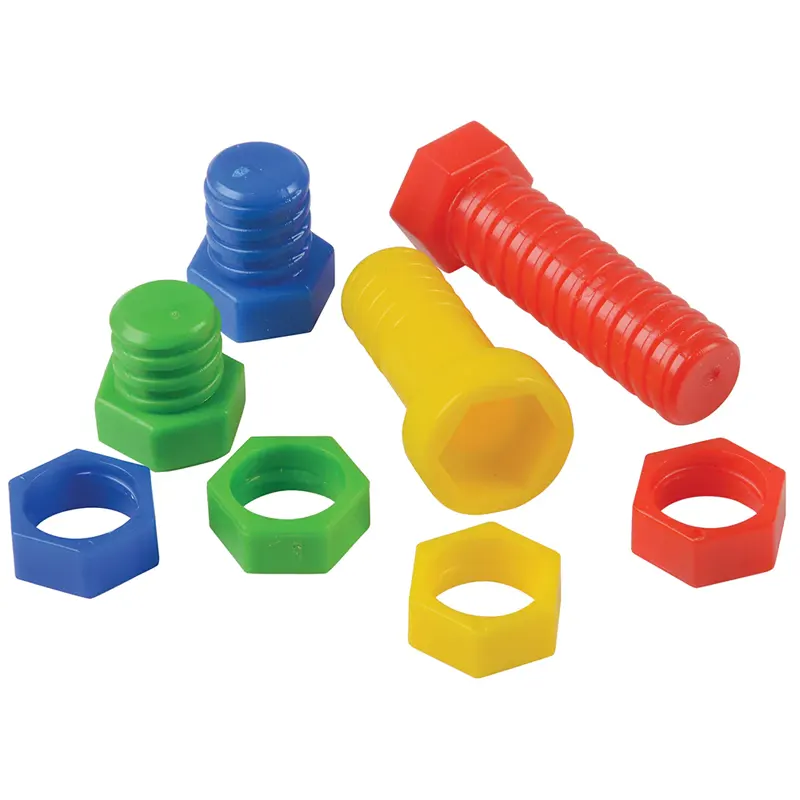
5. Dressing Boards and Practical Life Toys
- Button and Zipper Frames
Teach dressing skills while improving precision and hand coordination. - Soft Busy Boards
Combine zippers, laces, buckles, and snaps in one compact tool for everyday fine motor practice. - Pouring and Scooping Sets
Small pitchers, cups, and scoops teach careful wrist control and bilateral coordination—ideal for early self-care routines like pouring drinks or transferring snacks.
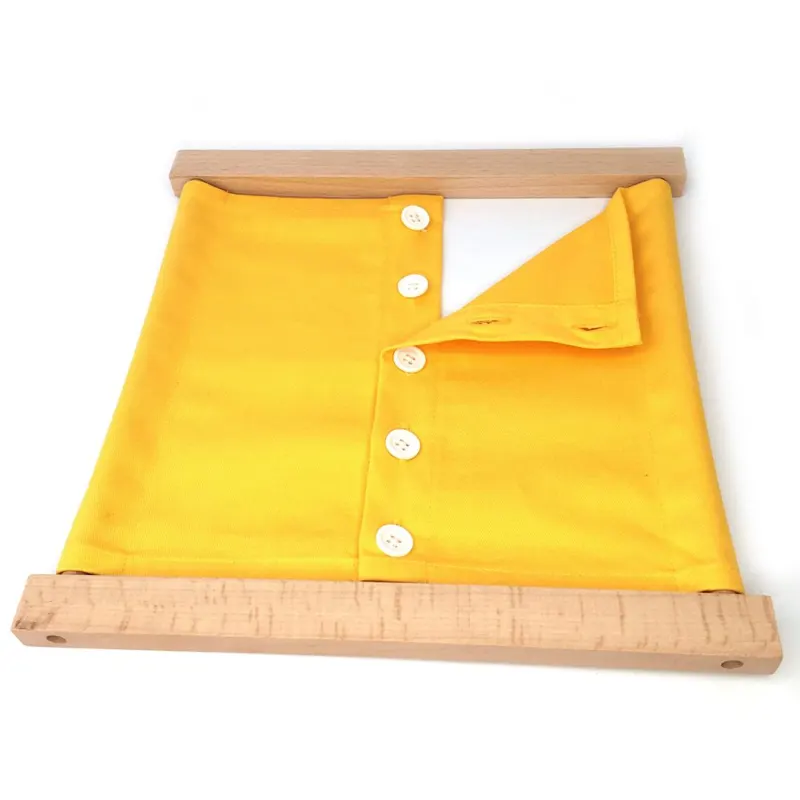

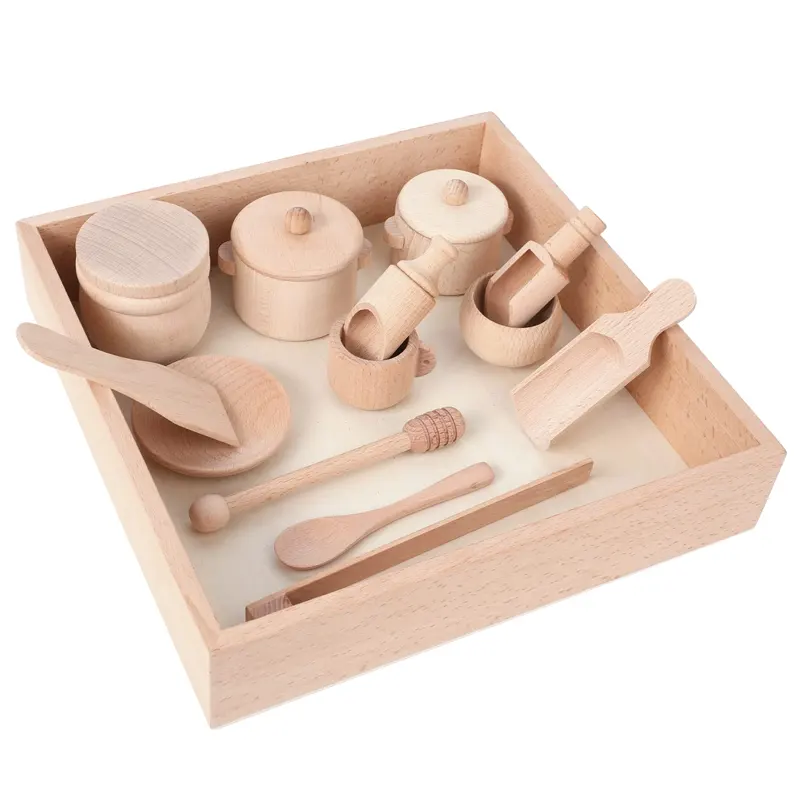
6. Tools and Tongs for Precision Practice
- Droppers and Squeeze Bottles
Require controlled squeezing, strengthening fingers while developing wrist stability. - Jumbo Tweezers
Help children pick up small objects and improve pincer grasp accuracy. - Scoopers and Spoons
Used in sensory bins to transfer items, building control and bilateral hand use.
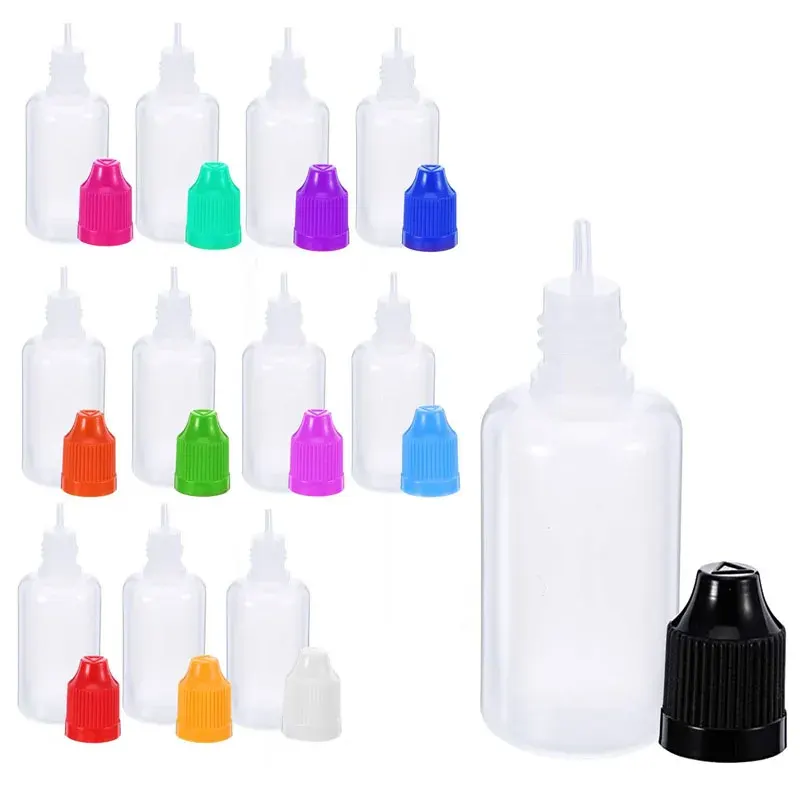
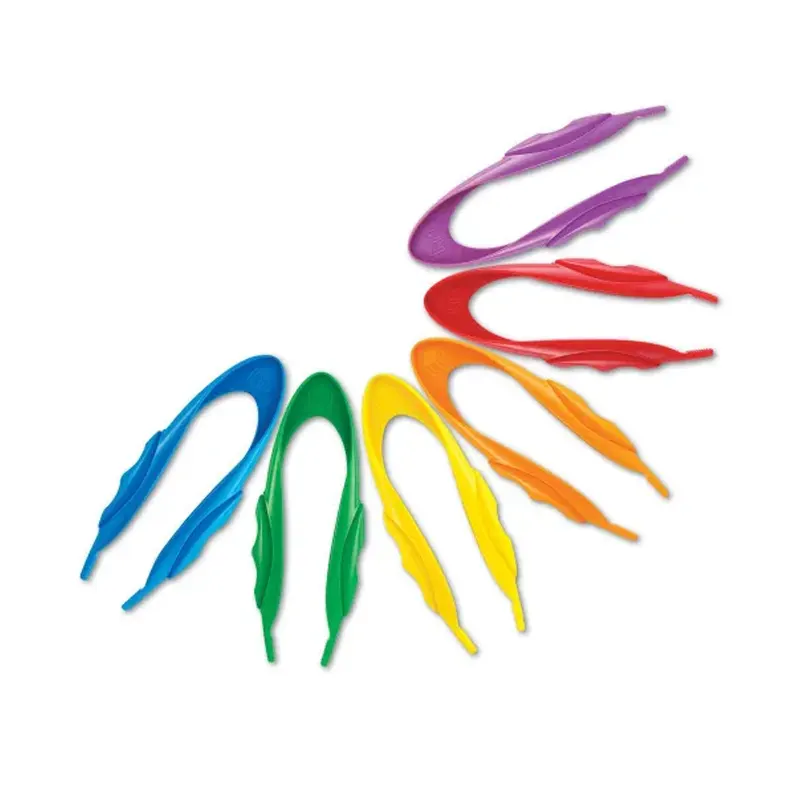
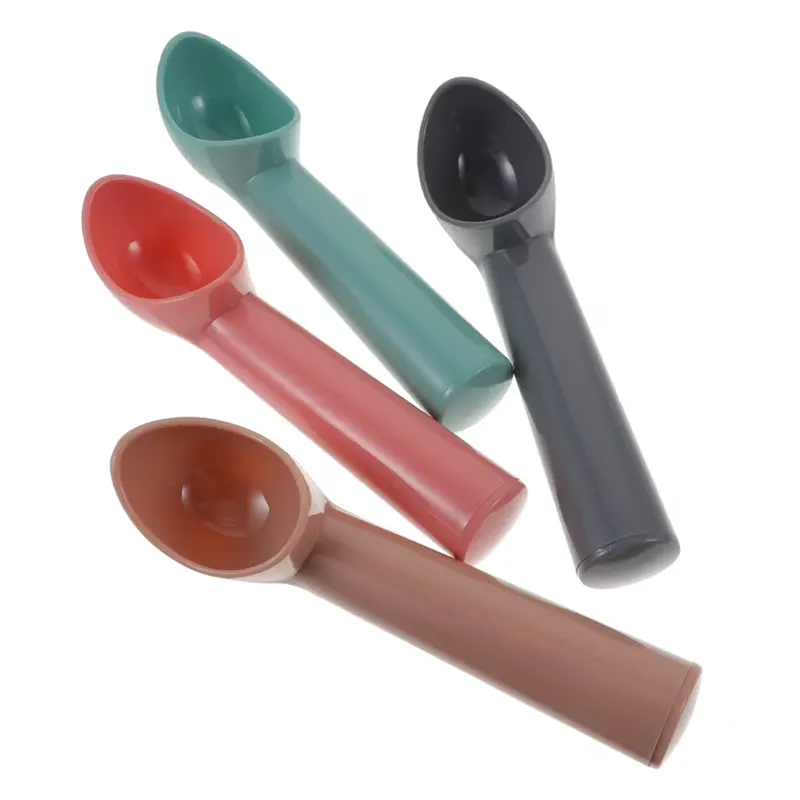
Kirimkan pesan kepada kami jika Anda memiliki pertanyaan atau meminta penawaran harga. Pakar kami akan membalas Anda dalam waktu 48 jam dan membantu Anda memilih produk yang tepat sesuai keinginan.
How to Work Out Fine Motor Skills Exercises?
Supporting the development of fine motor skills for preschoolers doesn’t require expensive equipment or complex routines. Some of the best fine motor exercises can be done at home or in the classroom using everyday materials. The key is to offer regular, playful opportunities that engage the small muscles of the hands and fingers in different ways.
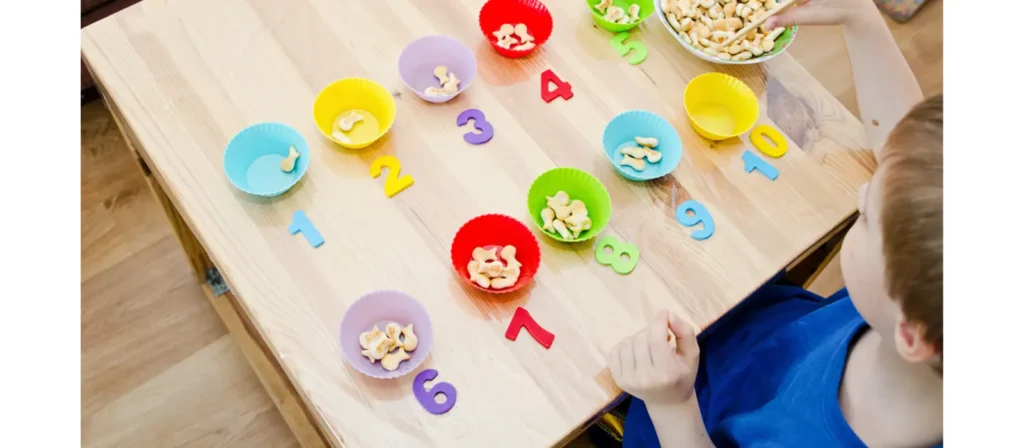
Start with Everyday Functional Movements
Fine motor development begins in the real world. Encouraging children to zip up their coats, open snack containers, brush their teeth, or help with folding laundry engages their hands in meaningful ways. These daily routines build not only motor strength but also a sense of accomplishment. By resisting the urge to do everything for them and instead allowing them to struggle, try, and succeed, caregivers provide the best kind of natural fine motor practice.
Use Household Items to Encourage Dexterity
There’s no need to invest in specialized toys when so many fine motor tools are already in your kitchen drawer or craft cabinet. Giving children child-safe tweezers, clothespins, or even a spoon to scoop dry beans builds control and precision. Wrapping rubber bands around cans or sorting coins into slots can also promote dexterity. These small-scale tasks create big developmental returns and make use of what’s already available.
Incorporate Sensory-Rich Experiences
Sensory materials are excellent for fine motor training because they invite manipulation. When a child presses playdough, squeezes a sponge, or scoops rice from one container to another, they’re strengthening small muscle groups without even realizing it. These kinds of activities also boost focus, regulate energy, and provide calming sensory input, making them a favorite for both parents and educators. Hands-on sensory experiences should be regular and varied to maintain interest and target different types of hand movement.
Create an Inviting Space for Hands-On Practice
A thoughtfully organized physical space can significantly boost a child’s engagement with fine motor tasks. Children are more likely to participate when activities are easy to access, visually appealing, and neatly arranged. This doesn’t mean overhauling your home or classroom—just a few smart layout decisions can make all the difference.
Here are some simple yet effective furniture and layout tips for creating a fine motor practice area:
- Low Shelving Units: Use open, accessible classroom shelving at the child’s eye level to store materials like puzzles, lacing boards, and manipulatives in clear bins.
- Adjustable Tables and Chairs: A child-sized table with comfortable seating allows for proper posture, making it easier to focus on detailed tasks like drawing, cutting, or threading.
- Activity Trays or Stations: Place different activities on small trays or in shallow baskets so children can choose what they want and clean up easily afterward.
- Wall-Mounted Pegboards: Hang tools like scissors, hole punchers, or measuring spoons within arm’s reach to encourage independence and routine use.
- Rolling Carts: For smaller spaces, use mobile carts with drawers or shelves to store and rotate fine motor materials weekly—this keeps things fresh and exciting.

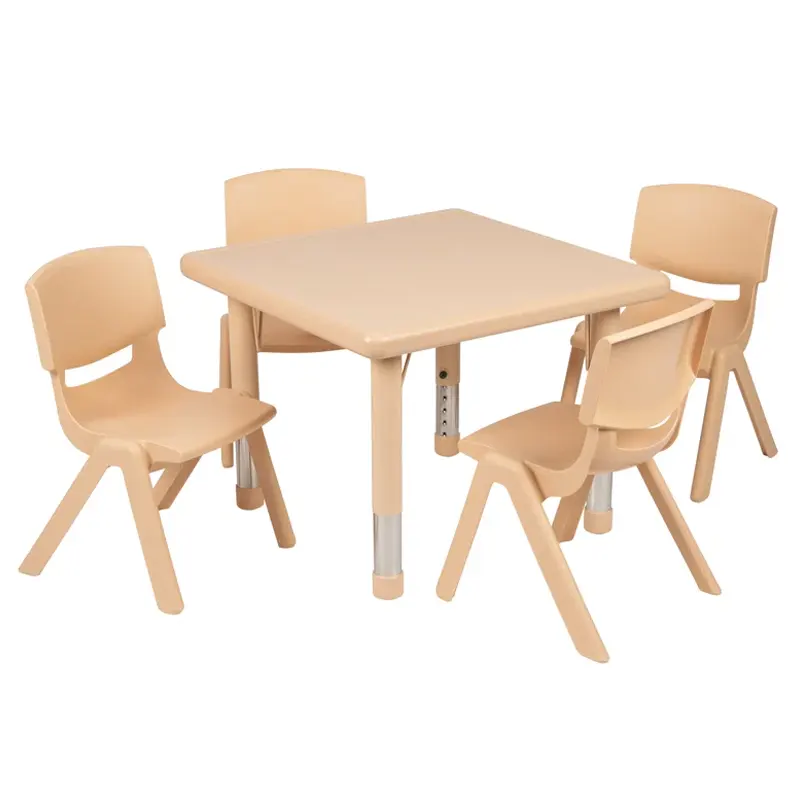
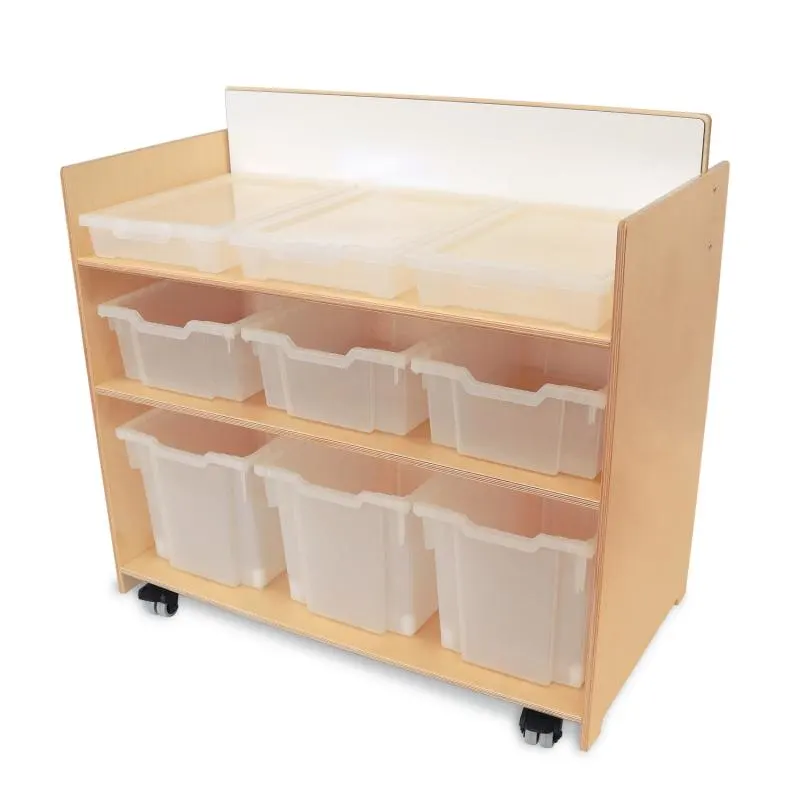
Make the space cozy and welcoming with good lighting, a soft rug, and maybe even child-made decorations. When the lingkungan kelas is inviting and the setup is intuitive, children will gravitate toward it naturally, and that means more practice, more progress, and more joy.
Kirimkan pesan kepada kami jika Anda memiliki pertanyaan atau meminta penawaran harga. Pakar kami akan membalas Anda dalam waktu 48 jam dan membantu Anda memilih produk yang tepat sesuai keinginan.
Make Fine Motor Practice Feel Like Play
Children learn best through play, and the same rule applies to fine motor development. Turning activities into challenges—like racing to string beads or building a tower from small blocks—adds a competitive edge that many children love. Role-playing, storytelling, or crafting games can also keep them invested while practicing crucial hand movements. When practice feels like fun, repetition comes effortlessly.
Be Patient and Celebrate Every Effort
Growth in fine motor ability isn’t always immediately visible. A child may struggle to hold scissors properly today, but improve dramatically within a few weeks of regular use. A supportive attitude, frequent praise, and a focus on effort over results help children stay motivated and positive. Every small achievement is a building block toward mastery.
Pertanyaan yang Sering Diajukan
- What’s the difference between fine motor and gross motor skills?
Fine motor skills involve small, precise hand and finger movements (like buttoning), while gross motor skills involve larger muscle groups used for walking, jumping, or climbing. - What are the best fine motor activities for preschoolers at home?
- Simple activities like play dough play, bead threading, sticker peeling, and clothespin games are excellent for home. These require minimal materials and offer strong fine motor benefits with hands-on fun.
- What should I do if my child gets frustrated with fine motor tasks?
Choose easier or more sensory-friendly alternatives, and offer lots of encouragement. Break the activity into small steps and allow them to pause when needed. Celebrate effort, not just results. - Can fine motor activities help children with developmental delays?
Yes. Tailored fine motor tasks can significantly support children with delays or disabilities, including autism. These activities should be sensory-aware, clearly structured, and introduced gradually. - Can everyday household items be used for fine motor practice?
Absolutely! Items like clothespins, pasta, cotton swabs, and bottle caps are great for squeezing, threading, sorting, and building fine motor strength at home. - How can I make fine motor activities more engaging for my child?
Use their favorite themes—animals, colors, or characters—and add playful challenges like races or counting. Involving stories or songs can also make repetitive tasks more fun. - How can I track my child’s fine motor progress?
Notice increased independence in tasks like feeding, dressing, drawing shapes, and manipulating small parts. Keeping a visual chart or video log can help track progress over time.
Kesimpulan
Fine motor activities for preschoolers and toddlers are more than just playful tasks—they’re essential building blocks for independence, academic readiness, and lifelong coordination. By offering consistent, engaging opportunities to pinch, grasp, scoop, and sort, we help young children strengthen the muscles and skills they need for everyday success.
Whether you’re a parent at home, a teacher in the classroom, or a therapist supporting developmental milestones, the key lies in choosing thoughtful, age-appropriate activities. Balance challenge with enjoyment, structure with creativity, and routine with flexibility. With the right approach, fine motor development becomes not just achievable but truly enjoyable.
Remember: every small motion your child practices today sets the stage for the bigger things they’ll master tomorrow.

